Beautiful House Plants With White Flowers | Our Top Pick For The Best 25 Beautiful Flowers
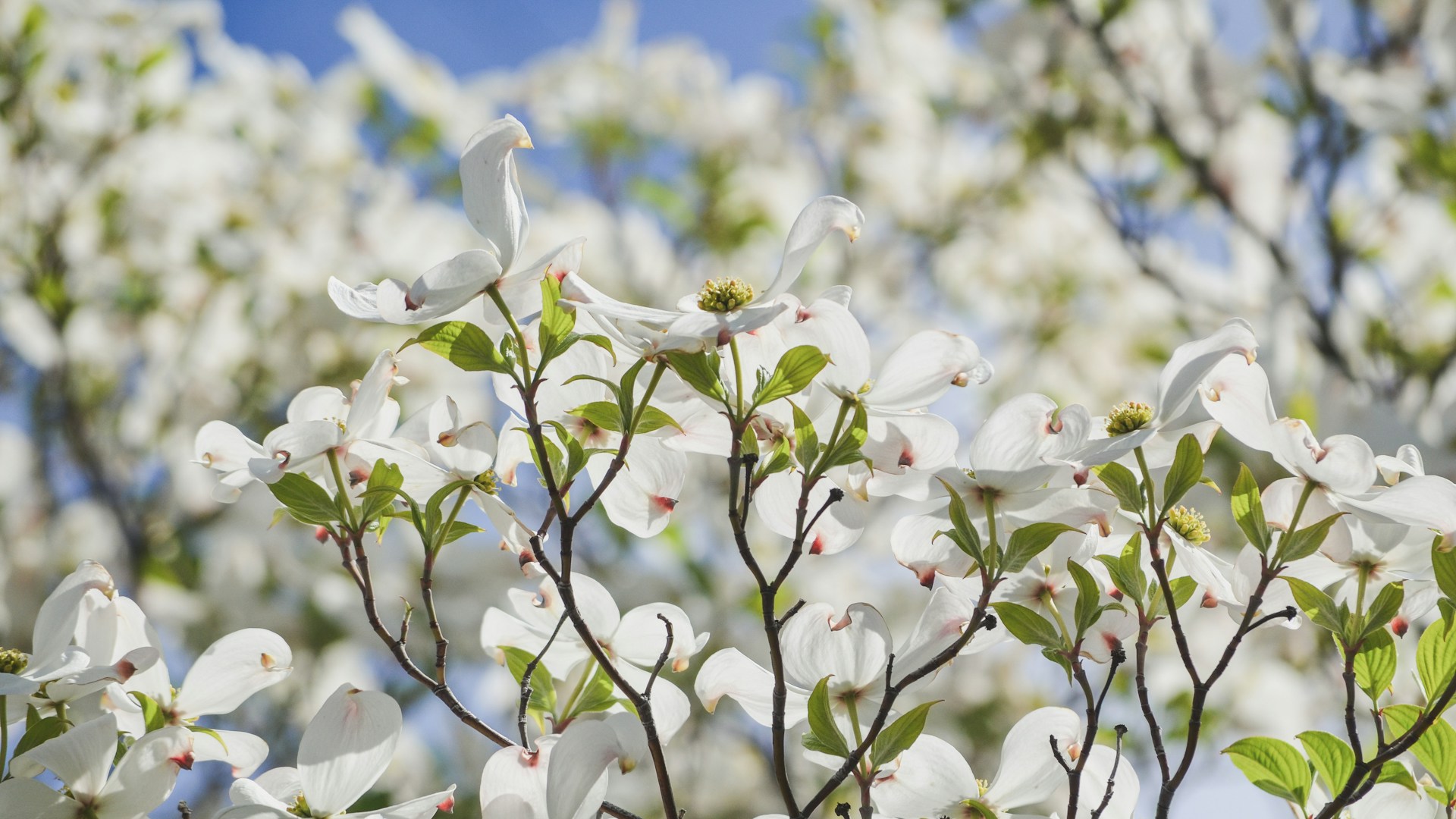
Introduction Of House Plants With White Flowers
In the whole world, there are many different kind of plants that we can grow in our garden as a house plant. Now you can ask why we should grow white flower plants in our garden! The answer is simple that everyone loves to see white as white often associated the purity, honesty and cleanness. Here you will know about top 25 house plants with white flowers in details.
So let’s start –
1. Gerbera Daisy
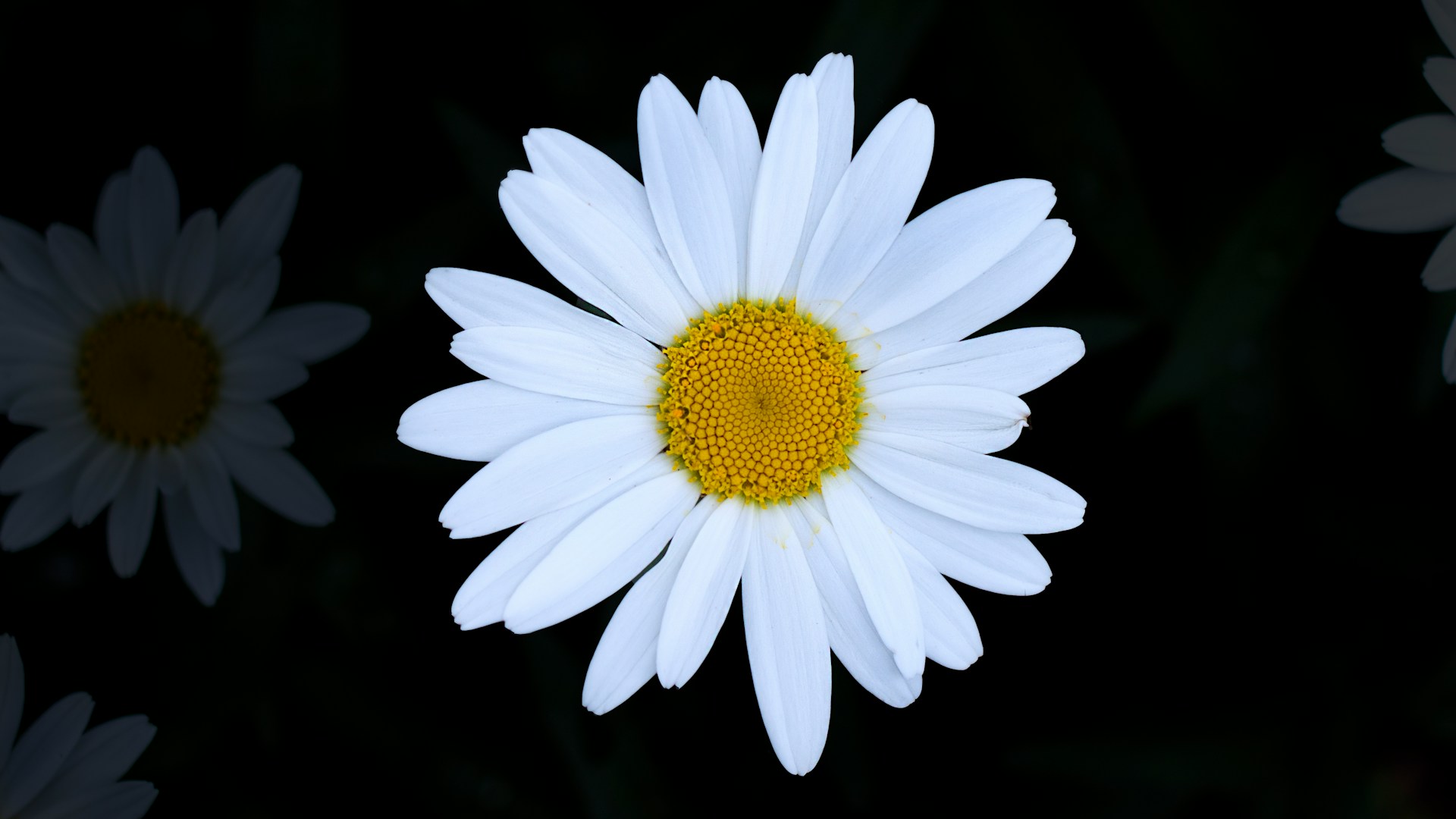
White Gerbera daisy is very beautiful with their large and bright blooms. There are also varied colors of this flower. It is one of the popular house plants with white flowers.
Gerbera daisy is native to South Africa and belongs to the Asteraceae family. The white color of this flower associated purity. They are symbol of beauty and innocence. They can be used in floral arrangements like bouquets, centerpieces, and as standalone cut flowers. You can grow them in your garden for floral arrangements and gardens.
Care Tips for Gerbera Daisies
Full sunlight is important for Gerbera daisies. At least 6 hours of direct sunlight is needed. Cacti or succulents mix soil are best for the plants. The soil must be well-drained. Water the soil if needed. Too much heat or frost is not appropriate for gerbera daisies. Temperatures between 65°F to 75°F (18°C to 24°C) is best for them. Over-water can damage the root rot so be careful about that. Spring and Summer are their growing season. You have to feed the soil with balanced fertilizer every 4-6 weeks during the growing season. Prune the plant to encourage new growth.
2. Peonies
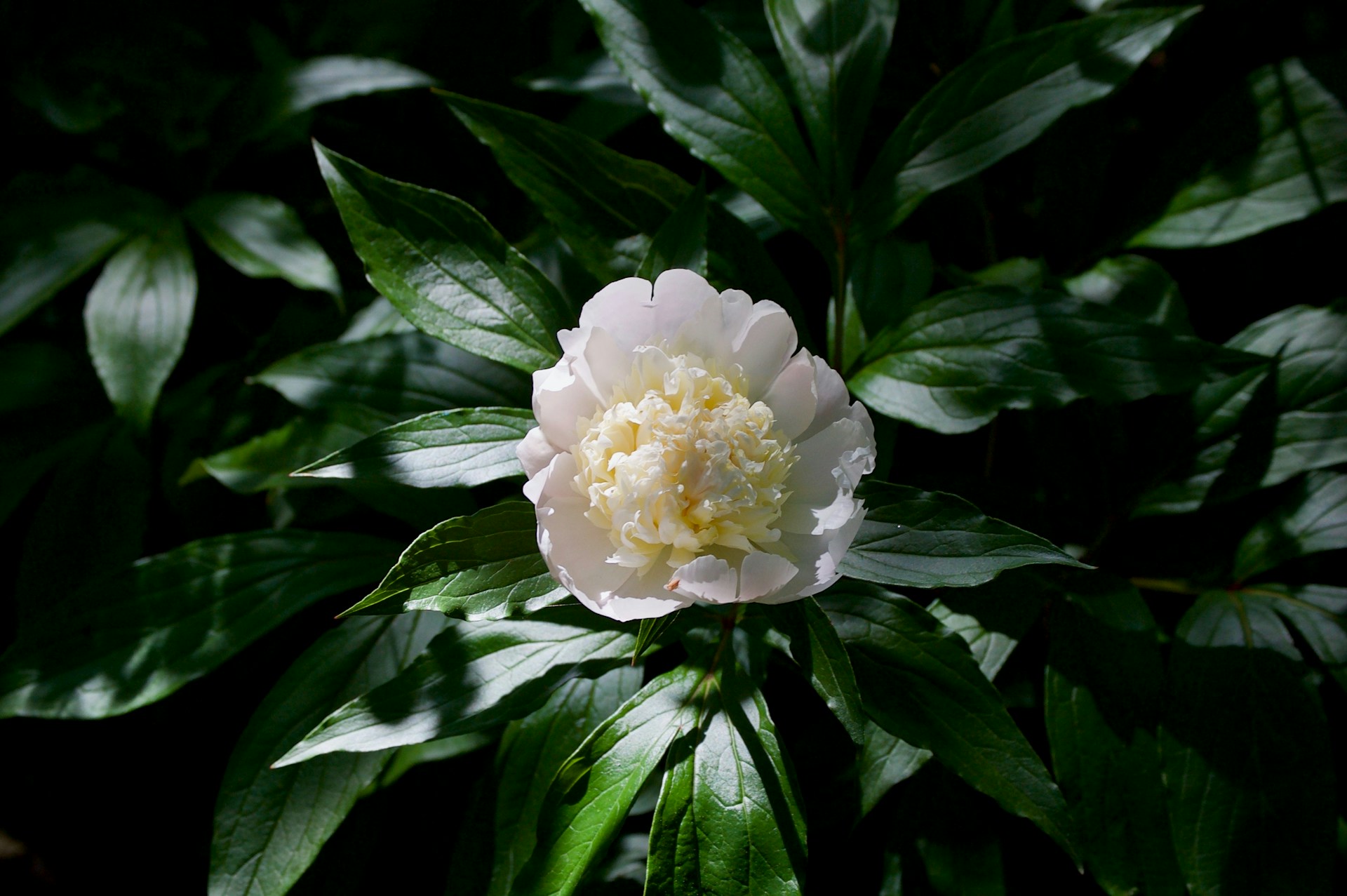
Peonies are popular as a house plants with white flowers. They have large, showy blooms, heady aromas, and plenty of personality. Its common name is Peony and botanical name is Paeonia Officinalis. It is a herbaceous perennial type plant. When they are matured, they can be 2-3 feet tall and 3-5 feet in wide.
Grow and Care for Peonies
Peonies needs full sunlight. The soil must be Well-drained. Soil with natural acidic pH is needed for peonies growth. They bloom during the spring and summer season. There are varied colors of peonies like white, pink, red, purple, yellow etc. Peonies hardiness zone is 3-9(USDA) and they are native flower of Europe. You have to give enough space to grow such as 3 to 4 feet diameter for each plant. For the best result, after blooming feed peonies with a mix of compost and a small amount of fertilizer once a year.
Common Pests & Plant Diseases of Peonies
Peonies can be attacked by ants and they can damage you plant. Gray Mold is also a common problem. This fungus can grow in cool and rainy weather. Flowers, leaves and stems can be damaged by gray mold. Removing and destroying the affected parts of the plant can be a solution of gray mold. Cut down to the base and remove debris. You have to use ground irrigation and improve air circulation. As a preventative, use a fungicide as .Powdery Leaves is an another kind of diseases. Full sun and air circulation can help to prevent this disease.
Also you can see brown or black spots in the plants. At that case, remove affected parts of the plant and improve drainage. You must avoid overwatering. Dark splotches on leaves is another types of disease. Hot and humid weather are responsible for this disease. They can cause peony leaf blotch. You should cut the peony to ground level in fall or early spring and improve air circulation to prevent dark splotches on leaves. Ground irrigation also can be used.
3. Hydrangea
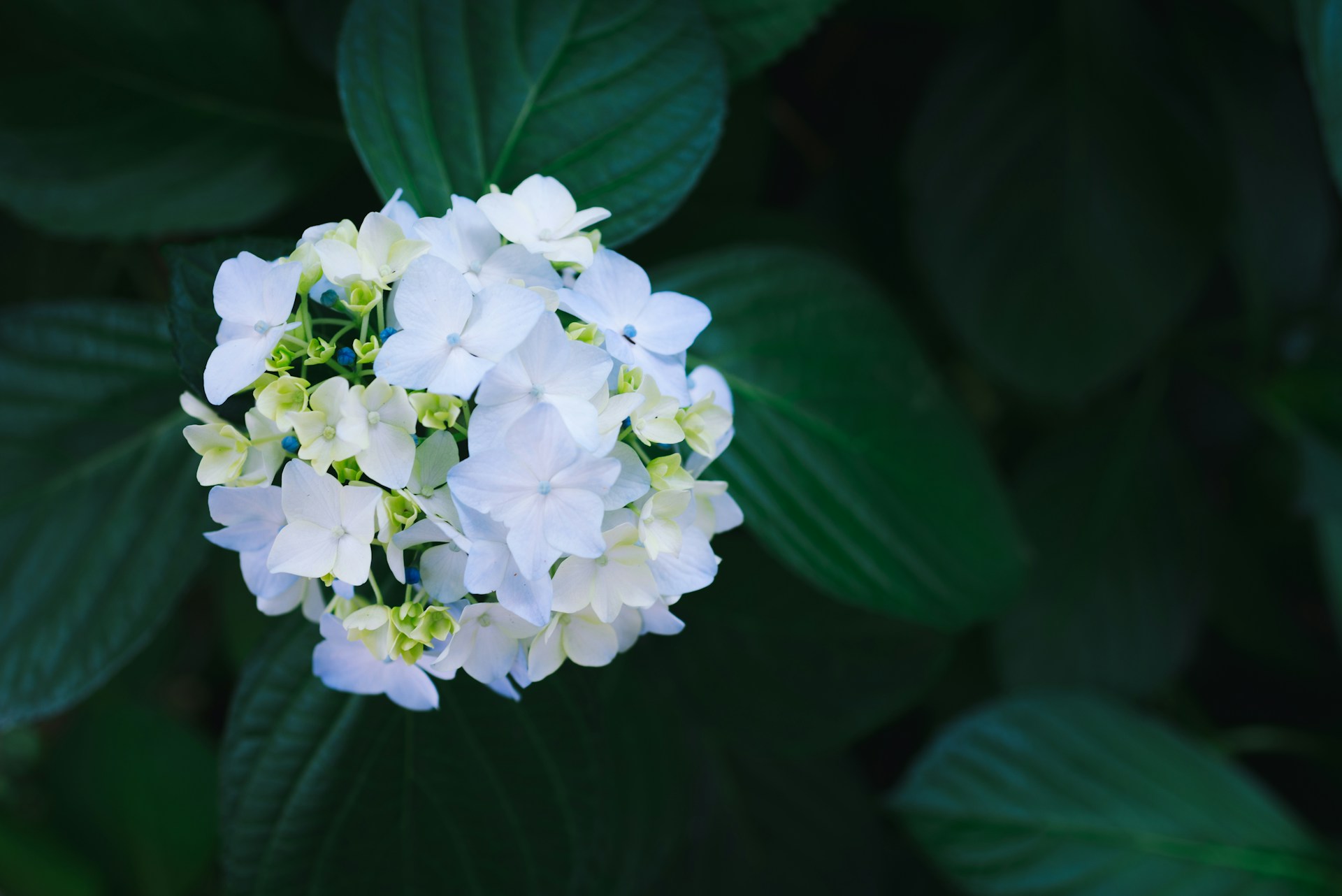
Hydrangea is a famous house plants with white flowers. They have large and beautiful blooms which is very attractive to all. Also they are able to change the color based on soil pH. Though they came in various colors, I love white Hydrangea flower most. The flowers can be different colors There are different types of flowers plants like mop head, lace cap, and panicle varieties depending on the species and environmental conditions.
Growing and Caring for Hydrangeas
At first select a suitable location. Before choosing a spot, keep it in your mind that the soil with partial shade, ideally receiving morning sun and afternoon shade is best for Hydrangeas. The soil should be well-drained and fertile. You can amend the soil with organic matter if needed. D on the variety spacing could be 3 to 10 feet apart. During dry spells you have to keep the soil consistently. You have waterlogging.
A balanced, slow-release fertilizer can be applied in spring. Pruning is also very important. Applying mulch can play an important rule to retain moisture and suppress weeds. Regular monitoring can prevent the common issues like aphids or powdery mildew. Also you can use insecticidal soap or fungicides if necessary. Hydrangeas can thrive and provide stunning blooms as a house plant with proper care.
4. Tulips
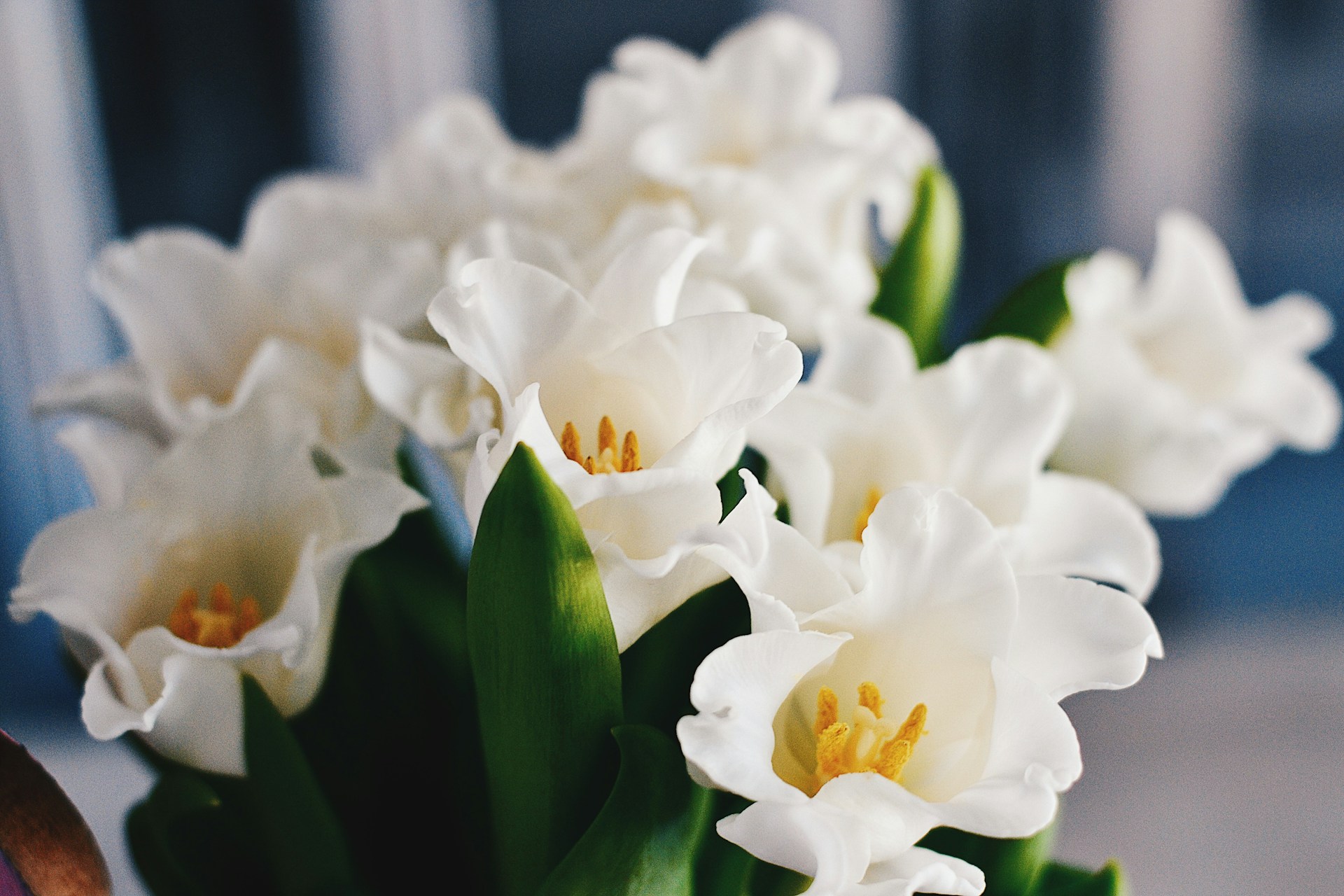
Tulip is a cup-shaped flower. It belongs to the lily family. They are native to Central Asia. Tulip is very popular as a house plants with white flowers. They come in a wide range of colors like white, red, yellow, pink, and purple. Tulips are a symbol of spring and in Netherlands tulips are celebrated with festival.
Growing and Caring for Tulips
At first choose the right location. Select a Well-draining spot is best for Tulip because it receives full sun to partial shade. Fertile, well-draining soil is necessary for this flower. Improve heavy soil with compost.
Tulip bulbs can be planted in the fall, about 6-8 weeks before the ground freezes. Depth and spacing could be 6-8 inches and 4-6 inches. Water the bulbs regularly but ensure the soil remains moist in spring as they grow. To retain moisture and suppress weeds, you can apply a layer of mulch. A balanced fertilizer in early spring is also good for growing. In colder climates, cover the planting area with mulch to protect bulbs from freeze-thaw cycles.
Pests and Diseases
Proper monitoring and care can prevent pests like aphids and diseases like bulb rot. Good drainage and proper spacing also good to prevent diseases.
5. Dogwood
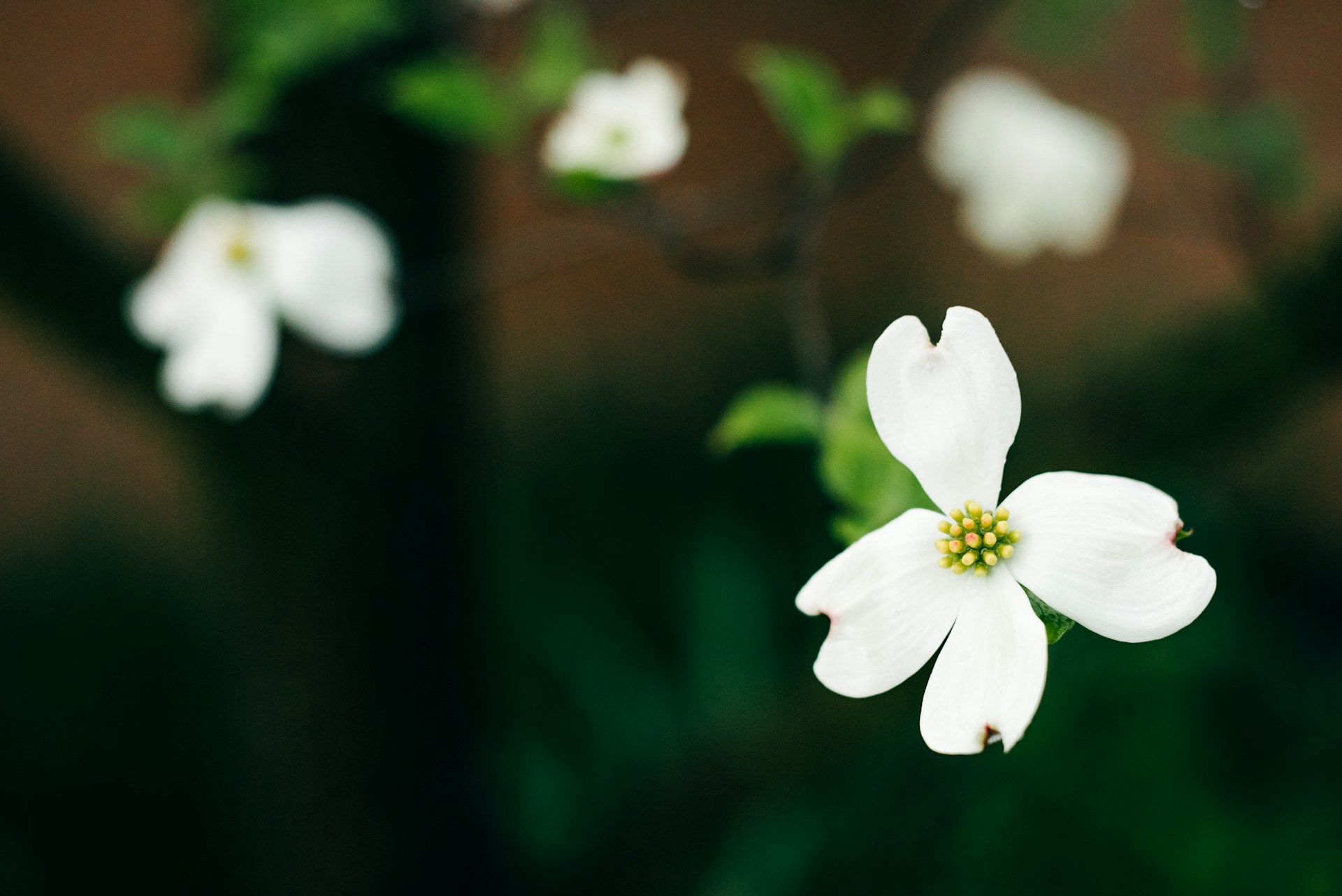
Dogwood flowers are popular over the world for their distinctive shape and beauty. You can easily grow them in your garden as a house plant with white flowers. Dogwood come in various colors and typically bloom in spring. Dogwoods can reach 15-30 feet tall and wide.
The most commonly recognized is the Eastern Dogwood (Cornus Florida), which features four large, petal-like bracts that surround the actual flowers. These trees are admired for their floral display, vibrant fall foliage and attractive bark. We often use dogwood in landscaping. They are associated with various cultural meanings, symbolizing rebirth and renewal.
Growing and Caring for Dogwood
A spot with partial shade to full sun can be chosen but remember that dogwoods thrive best with some protection from harsh afternoon sun. Well-drained and loamy soil is great for dogwood. Soil which is rich in organic matter can help you to have a healthy plant. Dogwood prefer slightly acidic to neutral pH. In dry spells, you have to keep the soil consistently moist but not soggy. Improve the soil with compost to promote healthy growth. You can apply a balanced and slow-release fertilizer in early spring. But remember that over-fertilizing should be avoided because this can harm the plant. Mulch is very useful to retain moisture and suppress weeds. Pruning in late winter or early spring is also important to remove dead or crossing branches, encouraging an open canopy.
Pests and Diseases
Anthracnose and powdery mildew are the biggest issues for dogwood. To prevent them, you have to monitor them properly. Good air circulation and proper spacing can help you in that case.
6. Hyacinth
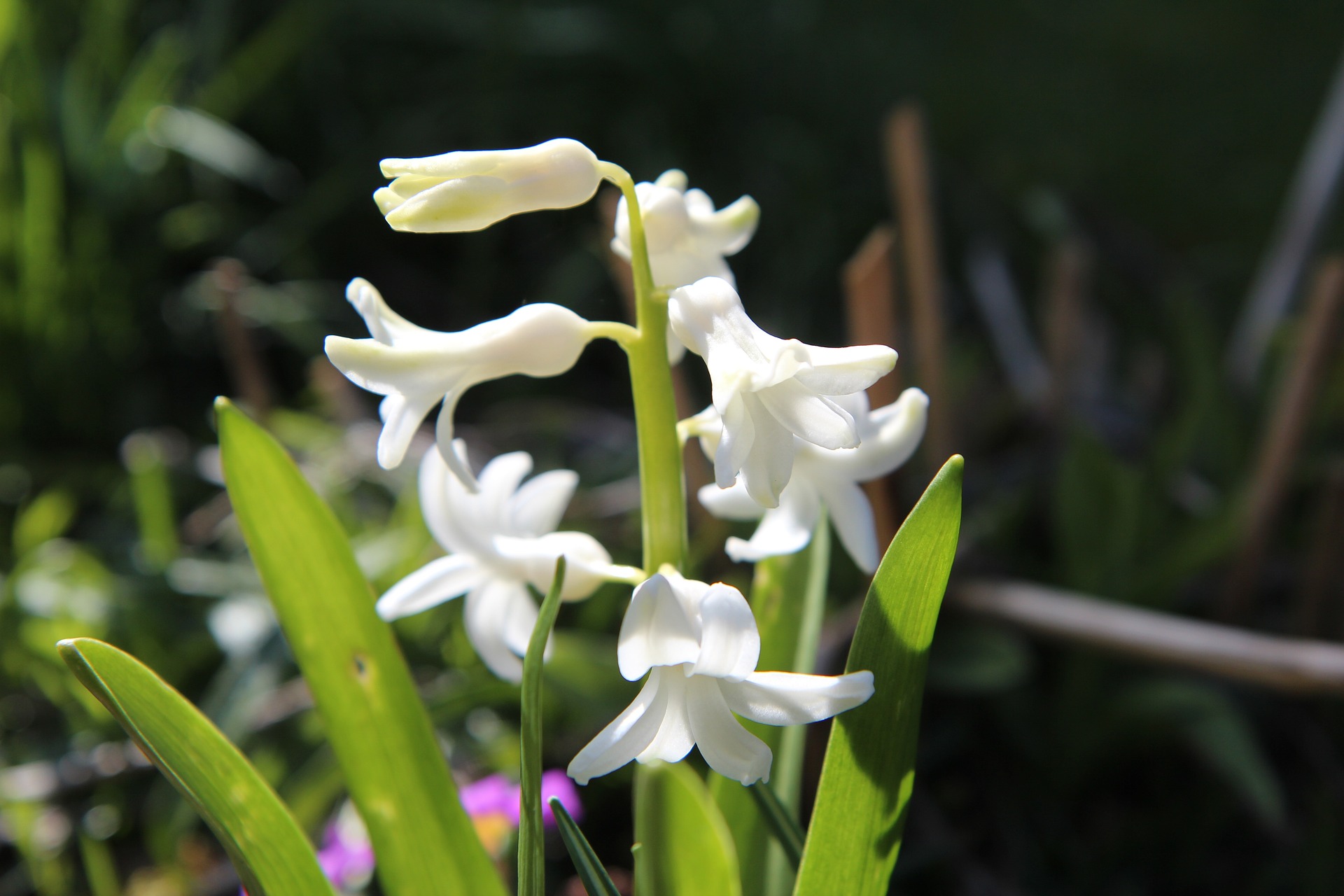
Hyacinth is famous for its fragrant blooms and vibrant colors. It is a bulbous flowering plant. This is native to the Mediterranean region. Hyacinths are popular in gardens and as a house plants with white flowers. They are favorite to all for their sweet scent.
Care for Hyacinths
Fall is the perfect time for planting hyacinth bulbs. Plant bulbs about 4-6 inches deep. The soil must be well-drained. Bulbs should be spaced about 3-4 inches apart. Hyacinth can thrive in full sun to partial shade. At 6-8 hours of sunlight is needed.
Keep the soil moderately moist and avoid waterlogging. A balanced fertilizer can be used in early spring to promote healthy growth. After blooming, let the leaves die back naturally.
Pests and Diseases
Some common pests are, bulb flies, aphids, spider mites etc. And some common diseases are, botrytis blight, fusarium rot, root rot etc. Good drainage, crop rotation, regular monitoring can help you to prevent diseases. Fungicides and Insecticides can be used as treatment.
7. Calla Lily
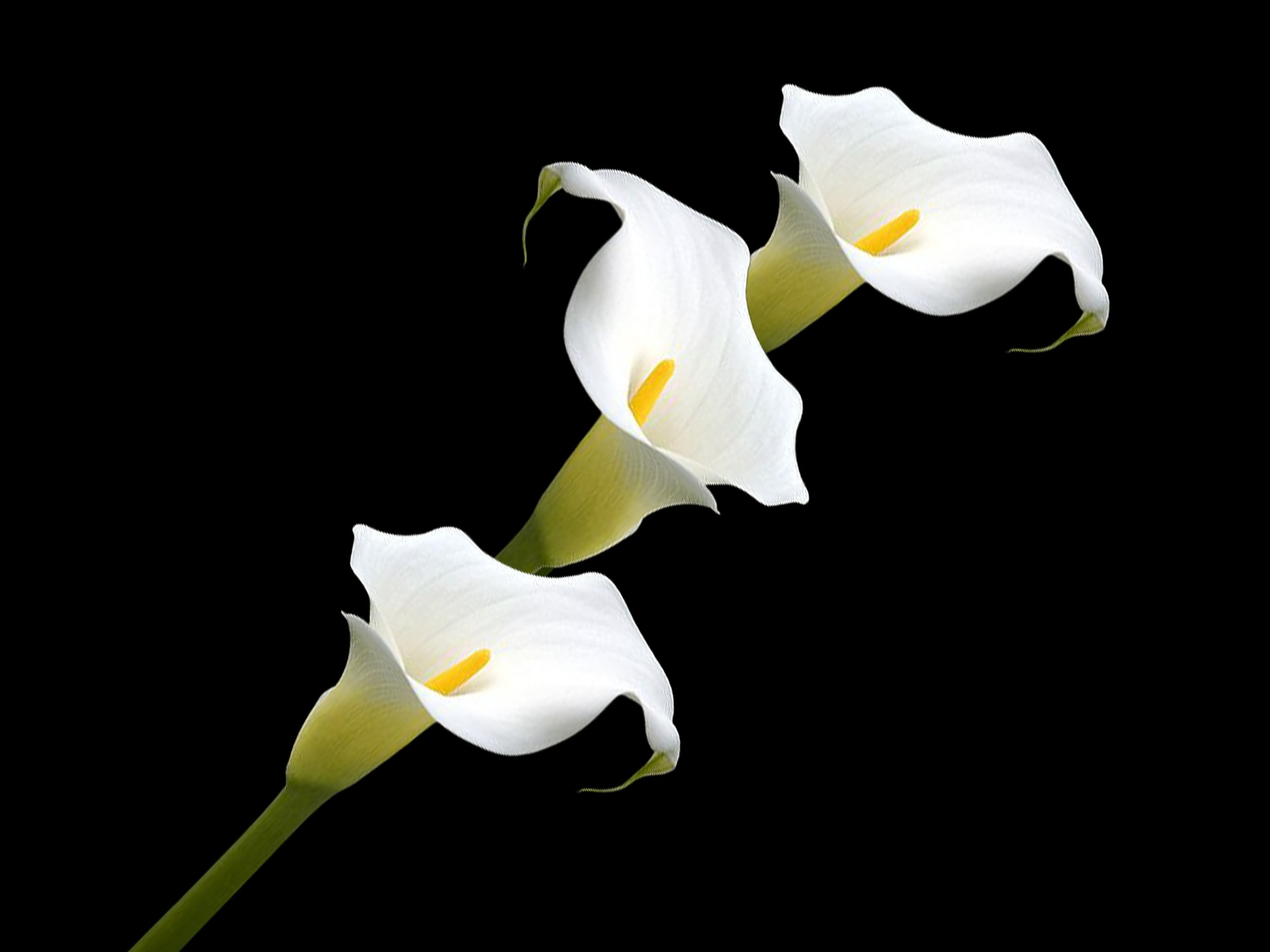
The calla lily is famous as an ornamental flower. It is popular for its elegant shape and striking appearance. White calla lilies are often associated with purity and beauty. They can be grown in gardens or as potted plants. They are often used for weddings and special occasions due to their sophisticated look in any floral arrangements.
Growing and Caring for Calla Lilies
Last frost is best for planting calla lilies plant. Spot with full sun and well drained soil are best for calla lily. For better result, you can amend with compost for added nutrients. The soil should be consistently moist but not waterlogged. During dry spells water the soil properly. Fertilizing is very important . You have to use a balanced fertilizer every 4-6 weeks during the growing season. Spent flowers and dead leaves must be removed to encourage new growth. Dig up the bulbs after the first frost and store them in a cool, dry place. They can remain in the ground in warmer areas.
Pests and Diseases
Aphids and fungal infection are the main pests and disease. proper monitoring and caring can help too. Insecticidal soap or appropriate fungicides can be applied if needed.
8. Snapdragon
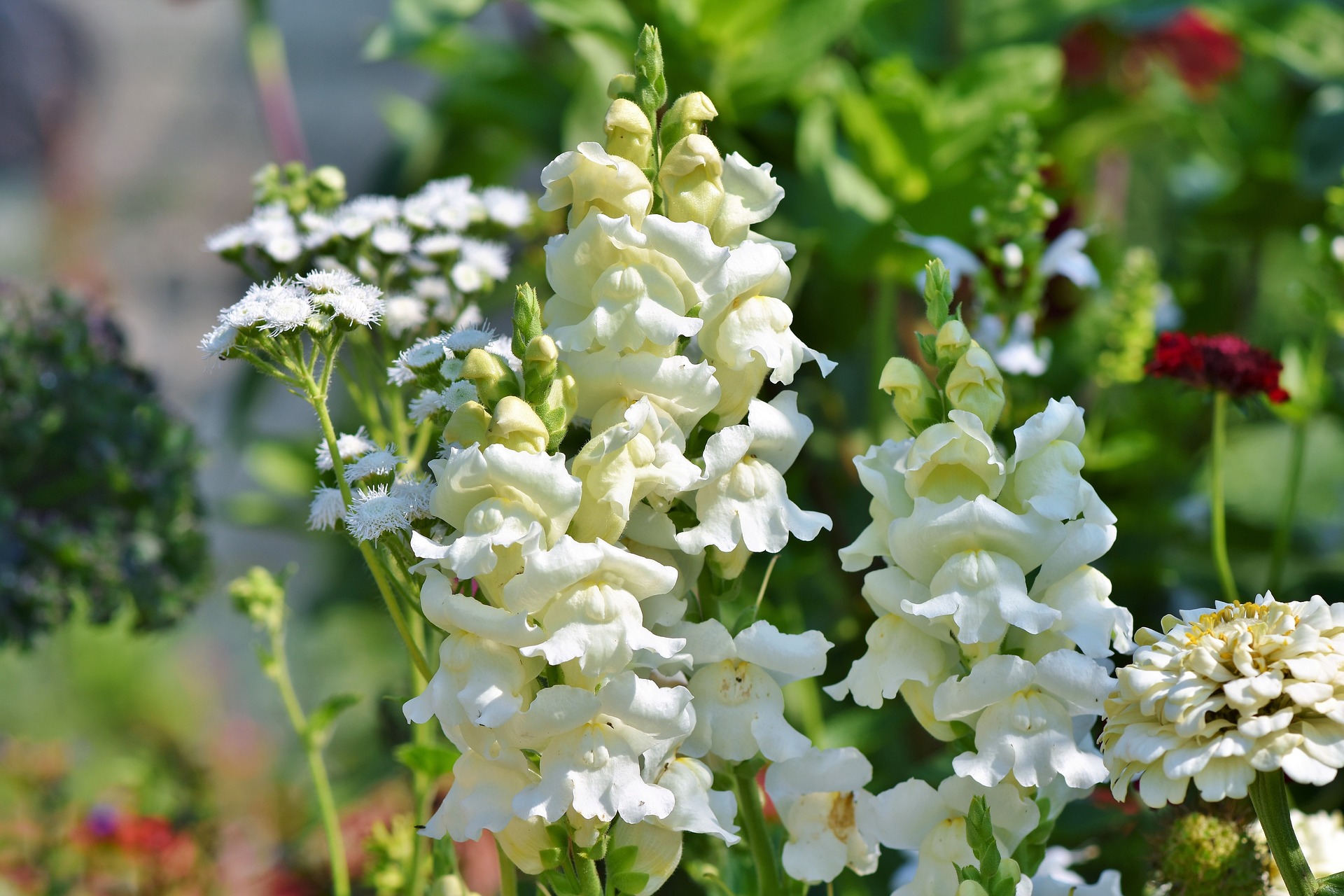
If you want to plant a genus of flowering plants in you garden, Snapdragon is perfect choice for you. It is member of the family Plantaginaceae. Their colorful and diverse blooms are favourite to all. They are used as ornamental plants. You can easily plant them as a house plant with white flowers.
Growing and Caring of Snapdragons
Early spring or fall is the perfect time for planting snapdragon. Mild climate is also important. Choose a sunny spot with well-draining soil. Snapdragons can thrive in full sun but also can tolerate partial shade. Soil with natural pH is best for snapdragon. The soil can be amended with compost to improve fertility and drainage. A slightly acidic to neutral pH is ideal. Seeds should be started indoors 8-10 weeks before the last frost date.
After starting seeds, transplant seedlings outdoors after hardening off. Another advice is, you can buy young plans from any nursery or market and then space them 6-12 inches apart. Regular water can keep the soil consistently moist but remember the soil must be not waterlogged. In cooler months, water is not necessary. Fertilizing is very important during the growing season. A balanced and slow release fertilizer can be applied. Prune the plants. It can encourage more blooms and prevent the plants from going to seed.
Pest and Disease Management
Keep an eye on your snapdragons plants for pests like aphids and spider mites. If necessary, insecticidal soap can be used. You have to ensure good air circulation to prevent diseases like powdery mildew. Also you can apply mulch to retain moisture and suppress weeds.
9. Daffodil
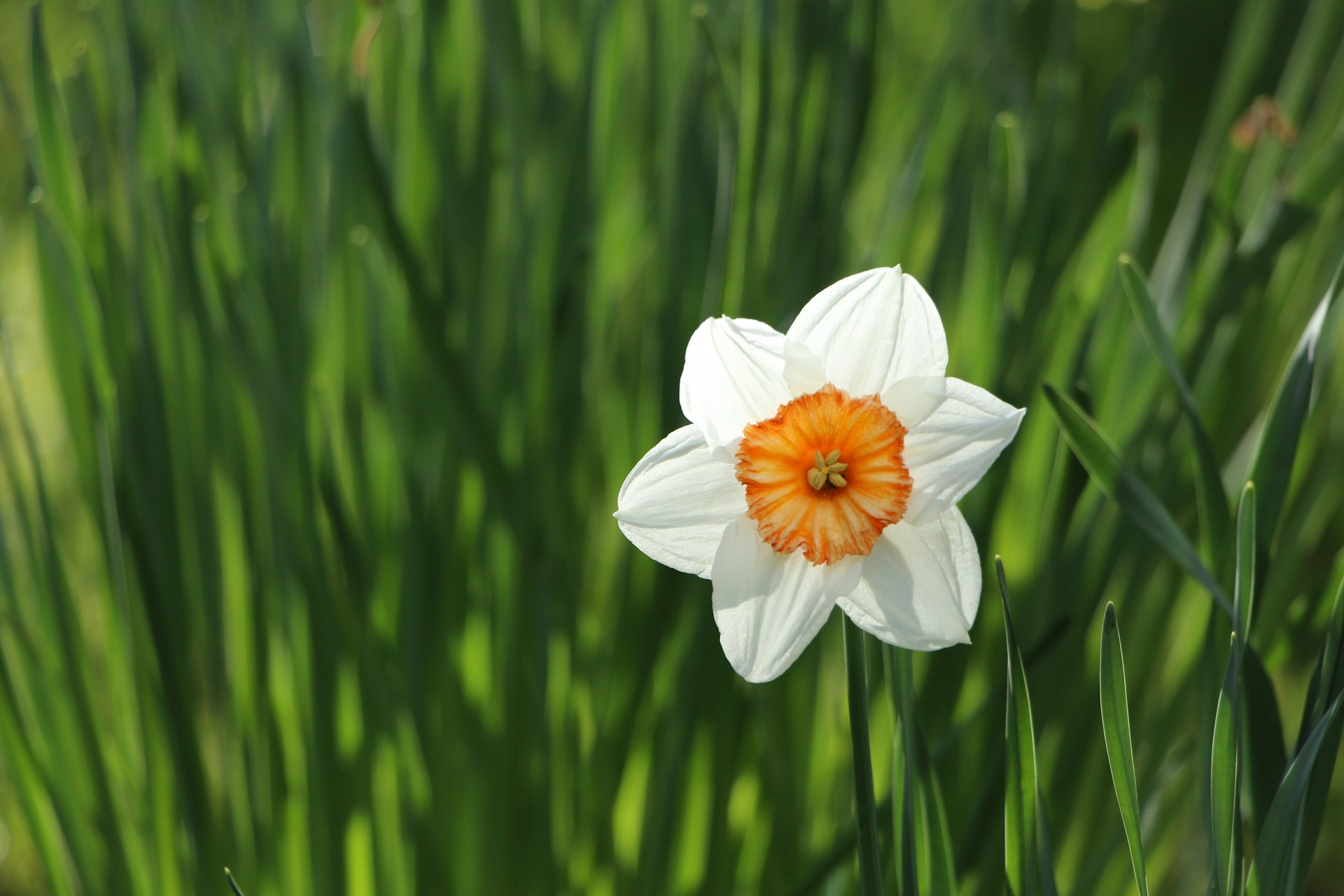
Daffodil is great as a house plant with white flowers. It is also known well for its bright yellow blooms. It is a perennial flower. It belongs to the genus Narcissus. Its beauty and ease of care can impress you in a second.
Growing and Caring of Daffodils
Daffodils blooming time is spring. But you have to plant the bulbs in the fall. The location must be a sunny spot as they prefer full sun to partial shade. They can grow well in well-draining and slightly acidic to neutral soil. Plant bulbs about 6-8 inches deep and 4-6 inches apart. Plant before the ground freezes. Water regularly and apply a balanced fertilizer. Soggy soil is not good for Daffodils. Apply fertilizer in growing season.
Pest and Disease Management
Not too much pests and diseases are seen, but you have to watch for issues like rot in overly wet conditions. Proper monitoring can help you. You may need to divide the bulbs to promote healthy growth in every few years.
10. Rose
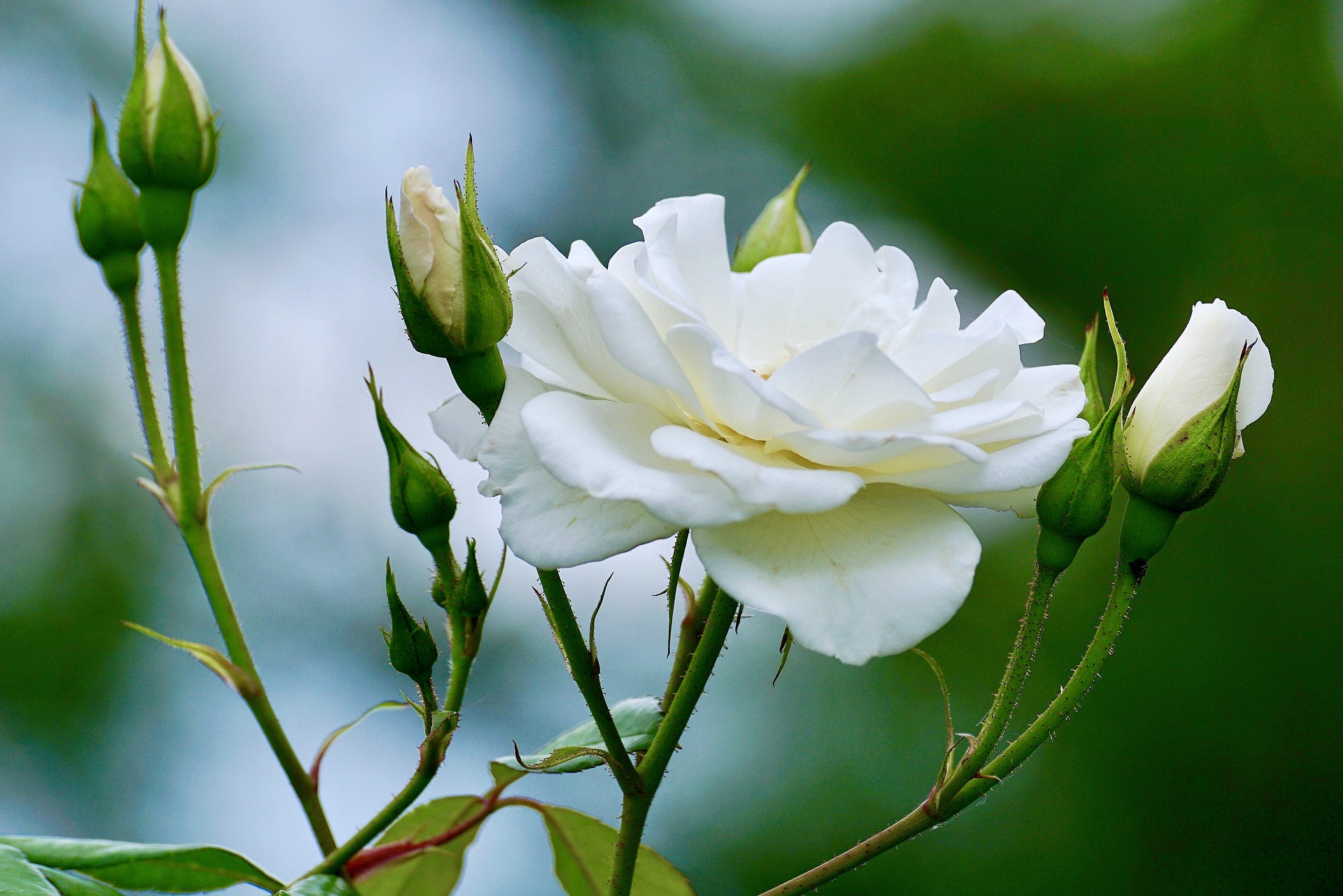
Roses are iconic flowers with various colors like red, white, yellow, pink etc. Each of the colors symbolize different emotions which is very impressive. Roses are known for their beauty. They belong to the genus Rosa. They are often used in bouquets and for special occasions as a cut flower. They are also famous for their cultural significance in literature and art, representing romance and passion.
Growing and Caring for Roses
Early spring or fall is perfect for planting. First of all choose the right type which is suited to your climate (e.g., hybrid tea, floribunda, climbers). A sunny spot can be selected as location. The spot should receive at least 6 hours of direct sunlight. Well-draining soil should be used. The soil must be rich in organic matter. If needed, improve the soil with compost.
Water the soil regularly and if necessary, use a balanced fertilizer in early spring and again in mid-summer. In late winter or early spring, Yoh have to prune the plants to remove dead or weak wood. Pruning is also important to shape the plant.
Pest and Disease Management
Proper monitoring can prevent the pests like aphids and spider mites. You can also use insecticidal soap or neem oil if necessary. By proper spacing and air circulation, and removing fallen leaves can prevent diseases such as black spot and powdery mildew. Mulching can help you too.
11. Candytuff
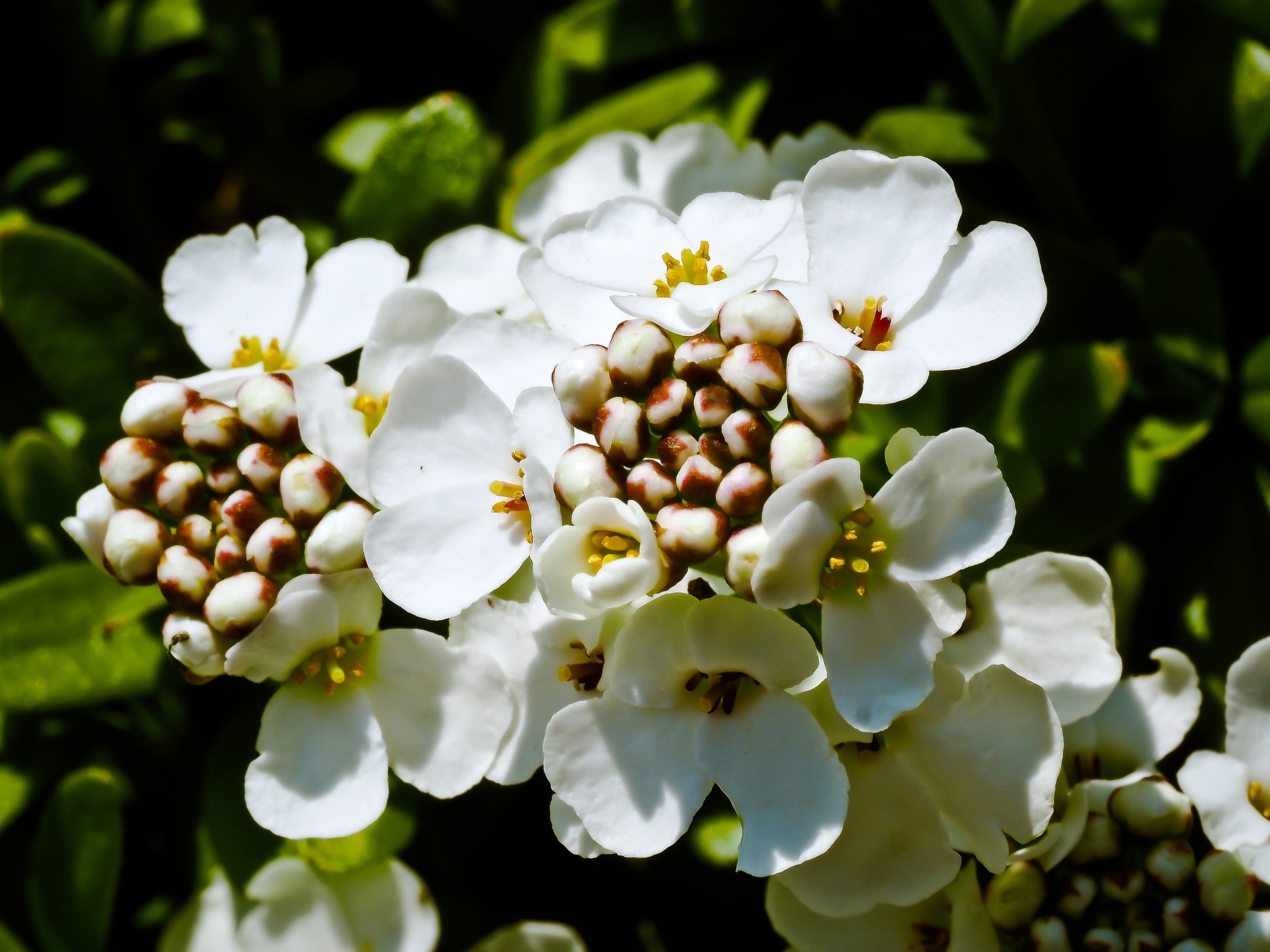
Candytuft is also called Iberis Umbellata. It is a perennial flowering plant. Cadytuff is popular for its bright white or purple blooms and attractive foliage. You can plant them as a house plant with white flowers. It is famous choice for rock gardens, borders, and ground cover.
Growing and Caring for Candytuft
A sunny spot should be chosen as location. Full sun (at least 6 hours a day) is preferred by candytuft. Well drained, sandy or loamy soil with a pH of 6.0 to 8.0 is great for them. Use heavy clay soils to improve drainage. In case of spacing, the plants should be spaced about 12 inches apart to allow for growth.
Regularly watering is essential, especially during dry spells. But the soil must not be waterlogged, as it can lead to root rot. A balanced and slow-release fertilizer should be used in early spring to promote healthy growth. Prune the plants to encourage more blooms and extend the flowering season. Cut back the foliage to maintain shape and promote new growth after flowering.
Pests and Diseases
Monitor regularly for aphids or spider mites. Water foliage can be a issue, so you have to ensure good air circulation to prevent fungal. More care is necessary in winter to protect the roots from frost.
12. Water Lily
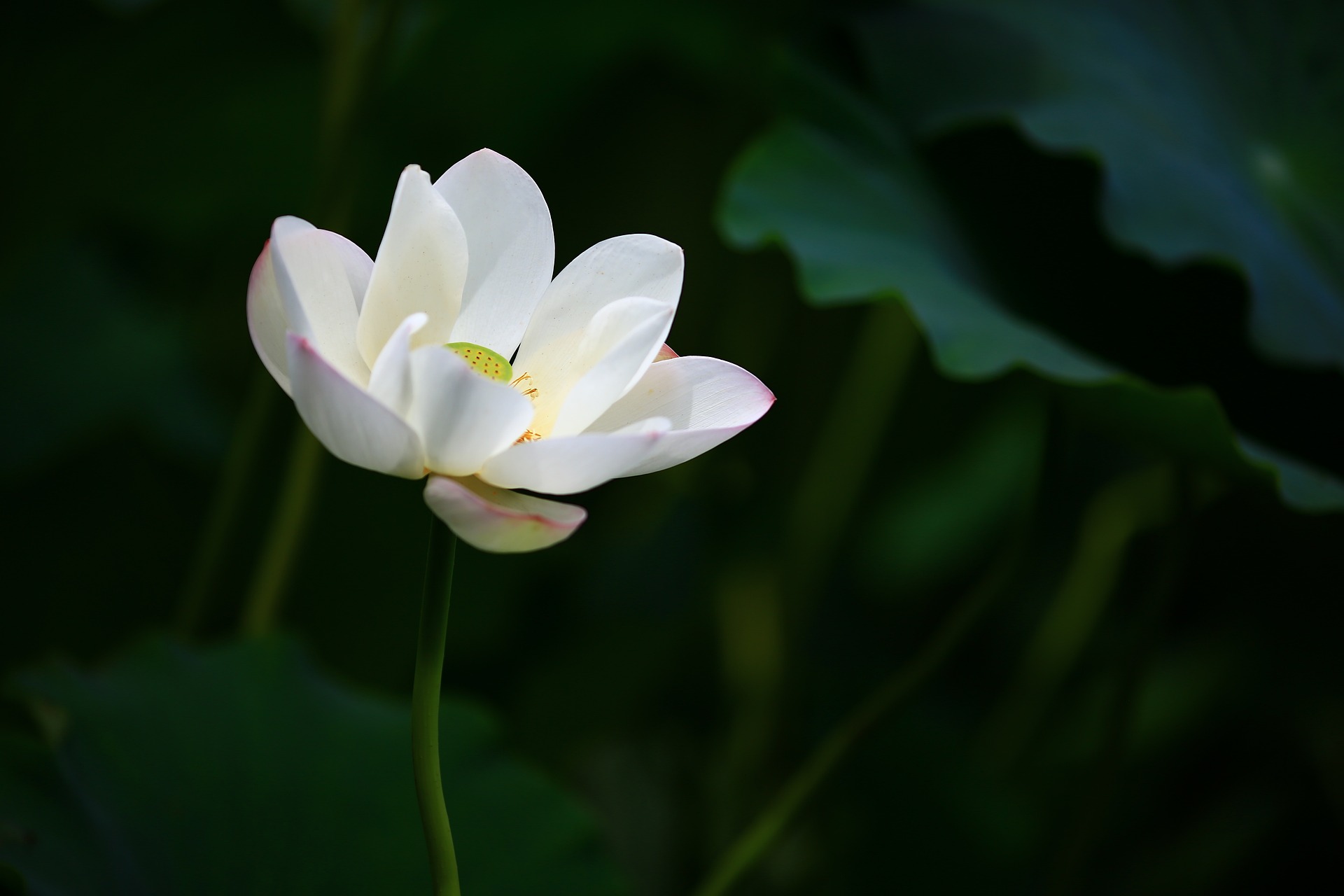
Water lilies are popular for their aquatic plants with large, flat leaves and stunning flowers. Their flowers float on the surface of ponds and lakes. Nymphaeaceae is the family of water lily. They come in various colors but white is the most favourite color to all. They are native flower of Bangladesh.
Growing and Caring for Water Lilies
Choose a right species that suitable for your climate and pond size like Nymphaea (hardy) and Nymphaea odorata (Tropical).
You can use both container or ponds. If you want to plant waterlily in container, you have to use wide, shallow containers with drainage holes. The container should be filled with loamy soil then plant the tuber about 4-6 inches deep. And if you want to plant them in ponds, you can plant them directly. In that case you have to ensure the tuber is buried 6-12 inches below the surface.
The surface depends on the species. At least 6 hours of direct sunlight daily is needed for optimal growth and flowering. Proper water depth should be maintained for the species you choose. In early spring, aquatic plant fertilizer tablets can be used when the plants begin to grow. The water must be clean. Avoid using harsh chemicals and check regularly for algae. You have to maintain a balanced ecosystem too. For healthy growth, remove any dead or yellowing leaves. The perfect time for pruning is after the blooming season. Pruning can prepare your plants fir winter.
Pest Management
By using natural methods and appropriate treatment, you can prevent pests like aphids or snails easily.
13. Cabbage Rose
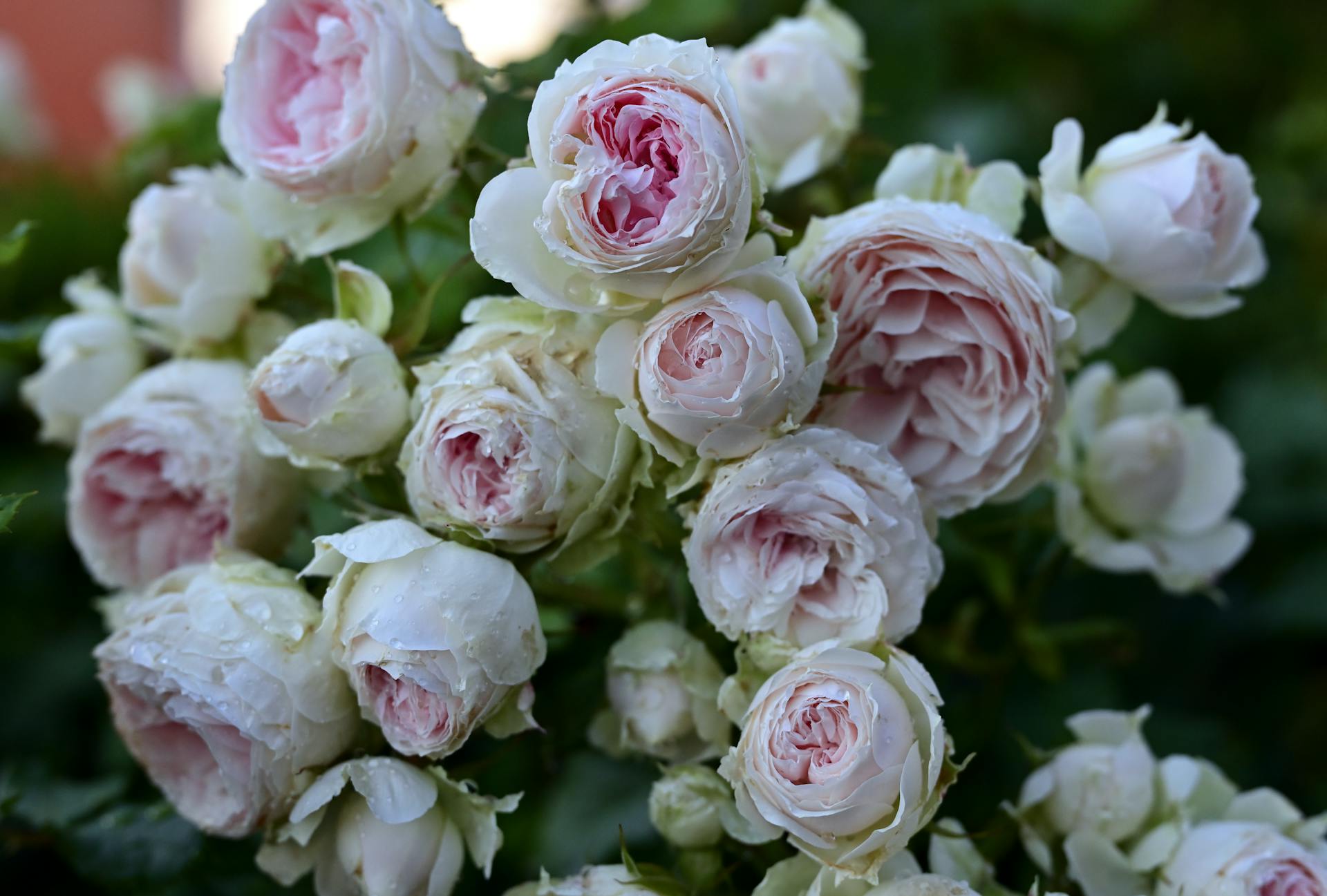
Cabbage roses (Rosa Centifolia) are famous for their dense, layered blooms that resemble cabbages. They are a type of old garden rose. Their flowers are large, fragrant, They are famous as a house plant with white flowers and dark green leaves. Cabbage Roses are great for gardens, borders, and as cut flowers.
Growing and Caring of Cabbage Rose
Full sun (least 6 hours a day) is needed for their proper growth. Soil should be well drained and rich in organic matter. Water regularly but avoid waterlogging. A balanced and slow release fertilizer can be used in spring and mid-summer. To encourage healthy growth and flowering, pruning is important.
Pests Management
Proper monitoring is needed for common pests like aphids and spider mites, treat as needed.
14. Prime Rose
“Prime Rose” is popular for their colorful blooms. It produces clusters of small flowers. There are different variety of colors, including yellow, pink, purple, and white. Their broad, oval leaves are very beautiful. It is excellent for borders, woodland gardens, and containers
Growing and Caring of Prime Roses
Though some varieties can tolerate full sun but prime rose prefers partial shade. Moist and rich in organic matter is great for them. The soil must be well drained. Water regularly to keep the soil consistently moist, especially during dry spells. Use a balanced fertilizer in spring. You have to prune the plants to encourage further blooming.
15. Begonia
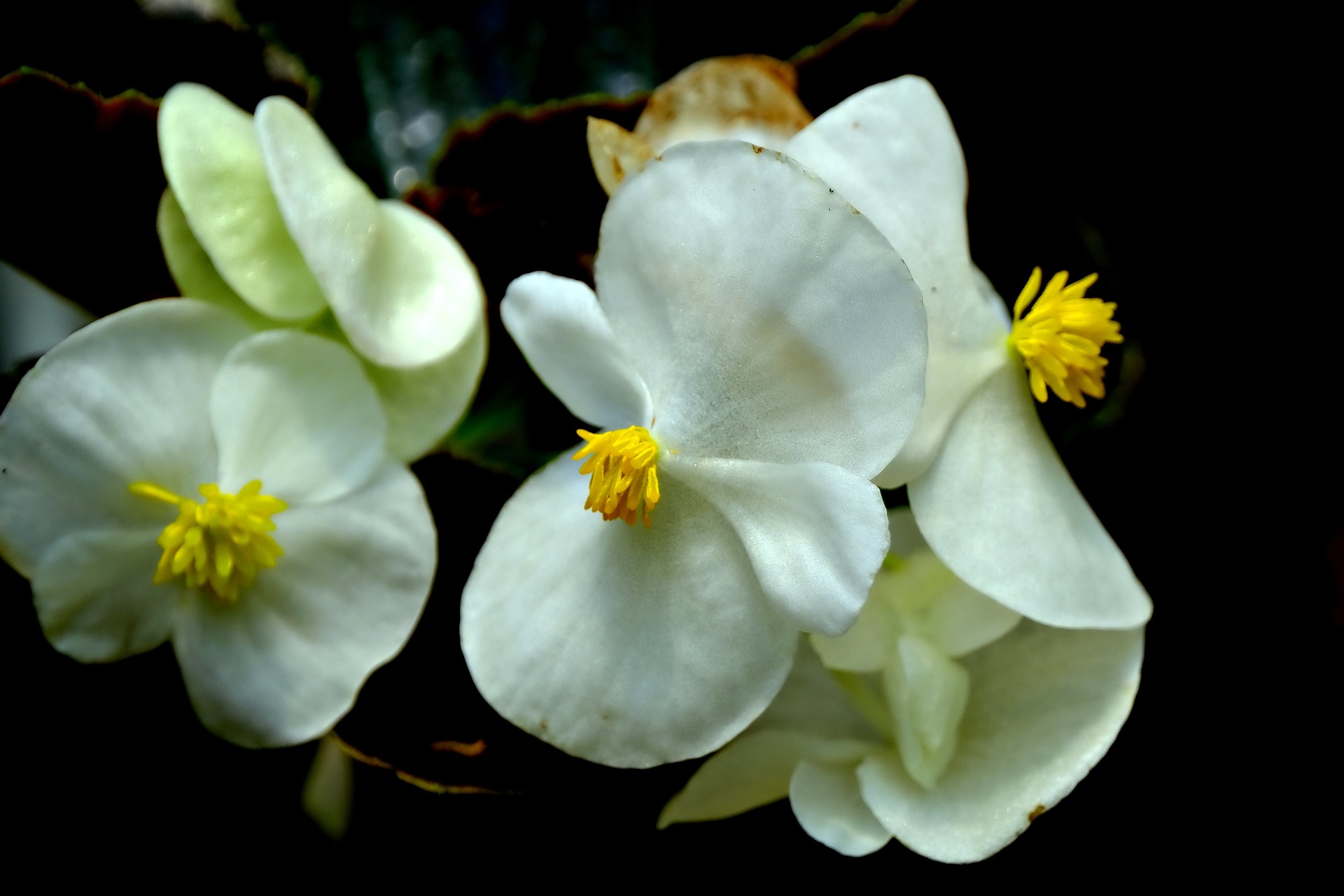
Begonia is famous as a house plant with white flowers. Their striking foliage and vibrant flowers are very beautiful. Their common size include Rex begonias. Rex begonias are known for their colorful and patterned
Growing and Caring for Begonia
Most begonias prefer indirect light because direct sunlight can scorch their leaves. Well drained and potting mix soil is best. Soil should be rich is organic matter. Always keep the soil consistently moist. The soil must not be soggy. you should consider misting them or using a humidity tray. Use a balanced liquid fertilizer every few during spring and summer.
Pests and Diseases
Always keep an eye on you garden for pests like aphids and spider mites. Avoid overwatering to prevent root rot. You have to ensure proper drainage to get perfect result .
16. Lupine
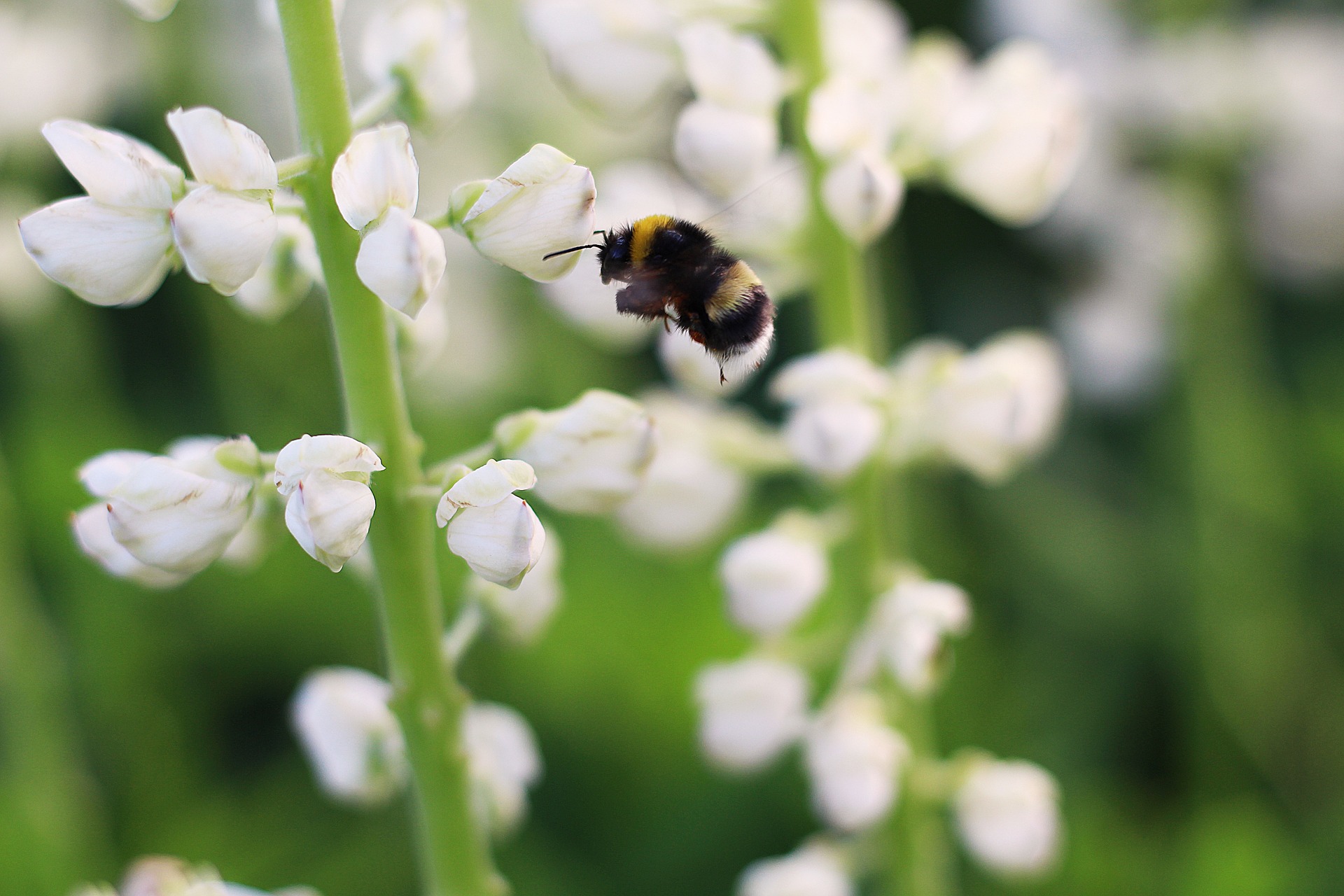
Lupines are also called as Lupinus. They are famous for their vibrant flower, spiky blooms and attractive foliage. Clusters of flowers can be produced that can be blue, purple, pink, yellow, or white. The leaves are looked like hand-shaped and can be quite striking.
Growing and Caring Conditions
Full sun is preferred by Lupines. This flower can tolerate partial shade too. Well drained soil with good fertility is best for them. Slightly acidic to neutral pH is also preferred by lupines. Avoid waterlogging and try to water regularly in dry periods. Lupines do not need heavy fertilization. But if necessary, a balanced fertilizer can be applied in early spring. Pruning is also important to encourage more blooms and tidy up the plant.
17. Chrysanthemum
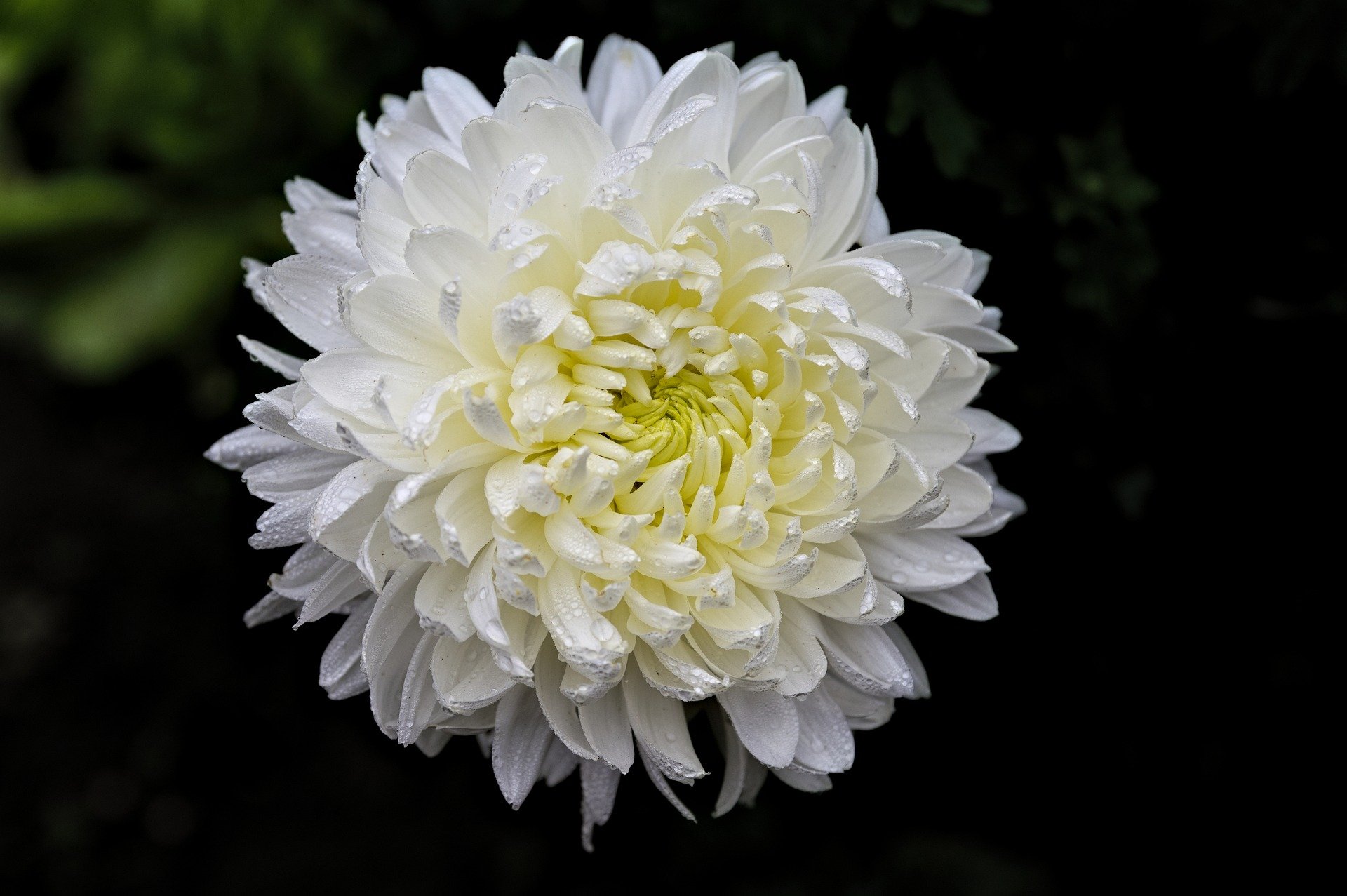
Chrysanthemums (mums) are very popular for their fall-blooming flowers value. They are also favourite to gardeners for vibrant colors and varied forms. They come in various colors like yellow, orange, red, pink, and white. Their flowers have different forms, such as daisy-like, pompon, and spider types.
Growing and Caring Conditions
Chrysanthemum grow well in full sun (at least 6 hours of sunlight per day). Well-draining soil which is rich in organic matter, best for this flower plant. Always keep the soil consistently moist. Especially concentrate on watering during dry spells. To prevent fungal diseases, avoid waterlogged. A balanced fertilizer can be used in spring and again in mid-summer to promote blooming. For pruning, at first pinch back the tips of the plants in early summer. Pruning can encourage bushier growth and more flowers.
Pests and Problems
Always keep an eye on plants to prevent aphids, spider mites, and whiteflies. Good air circulation can be helpful to prevent powdery mildew.
18. Cosmos
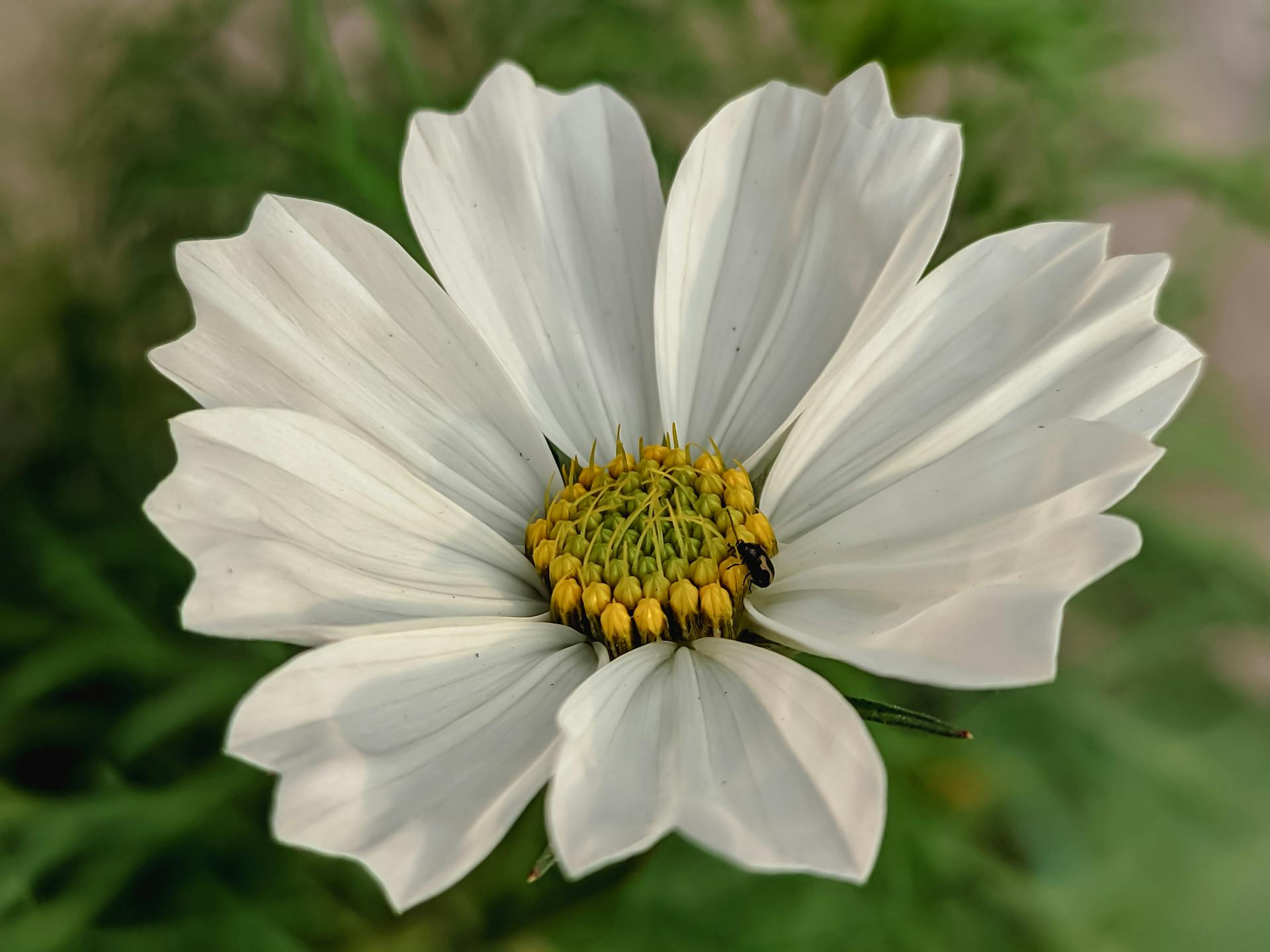
Cosmos is a very beautiful house plant with white flowers. This flower is cheerful, easy-to-grow annual flowers that are popular for their vibrant blooms. Cosmos can easily attract the pollinators. Cosmos flowers come in various colors like pink, white, orange, and red. They growth can be 1 to 6 inches in diameter.
Growing Caring of Cosmos
At least 6-8 hours of sunlight each day is needed for Cosmos tree. The soil should be well drained and moderately fertile. Though Cosmos can tolerate poor soil but benefit from some organic matter. Water regularly and remember that the soil must not be waterlogged. Apply minimal fertilization and a light application of balanced fertilizer in spring. This fertilizer can support growth. Remove the spent flowers regularly to encourage continuous blooming throughout the season.
19. Yarrow
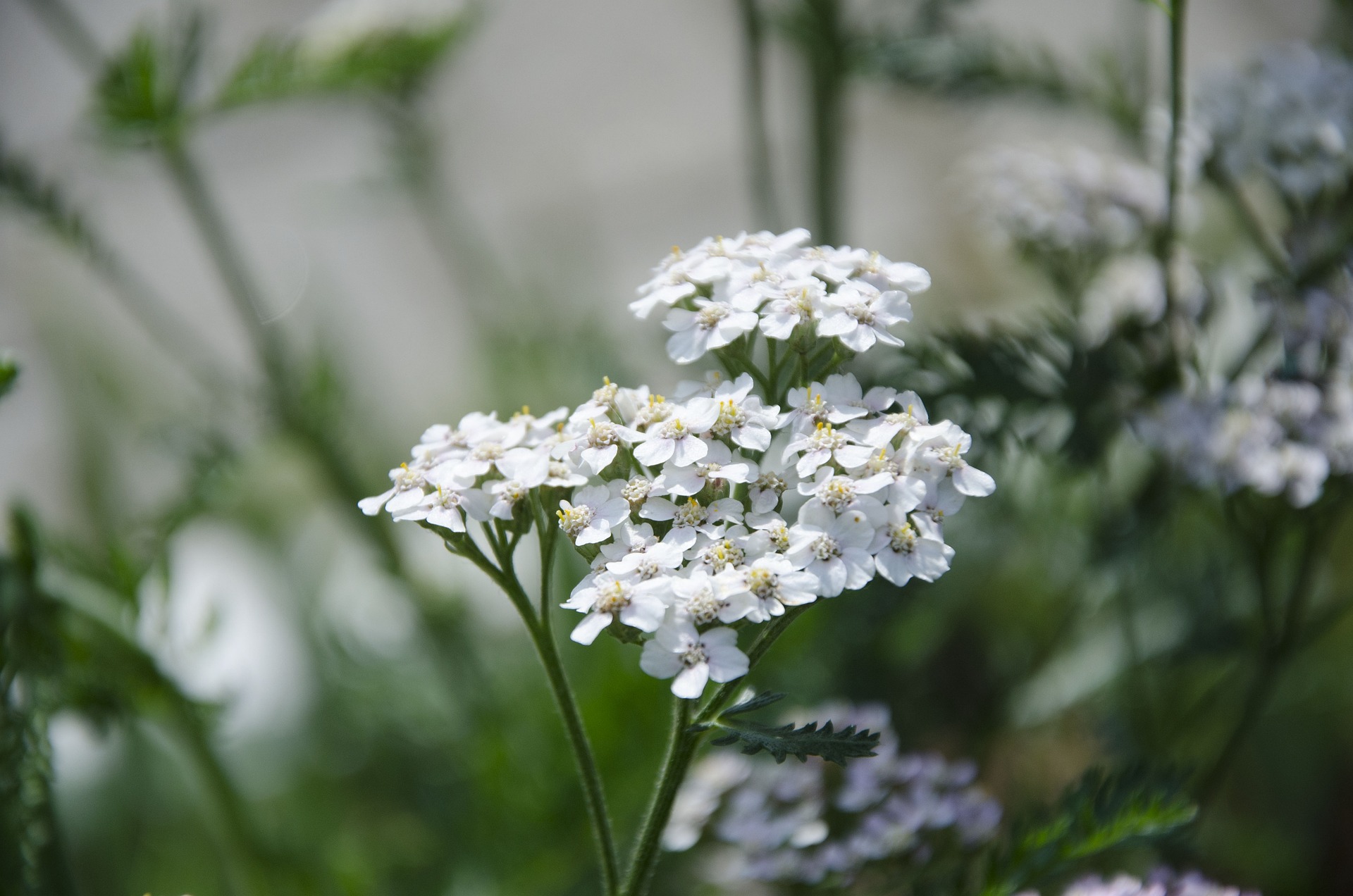
Yarrow is also called Achillea millefolium. It is a hardy perennial. This is famous for its feathery foliage and flat-topped clusters of small flowers. You can plant it as a house plant with white flowers to add beauty in your garden. The flowers attract pollinators too. Their finely divided and aromatic leaves are very beautiful and often with a gray-green hue.
Growing and Caring Conditions
Like other flowers plants, Yarrow needs full sun to thrive well. This flower can tolerate any types of conditions but well draining soil is best. Regular watering is very important during the first growing season. It can establish the roots. Fertilizer is not needed too much but a light application in spring can promote growth. On the other hand, pruning can encourage a second bloom and maintain a tidy appearance.
Pests and Problems
Though yarrow is resistant to pests and diseases but sometimes it can be attacked by aphids and powdery mildew in humid conditions. Proper monitoring and caring can prevent pests and diseases.
20. Ranunculus
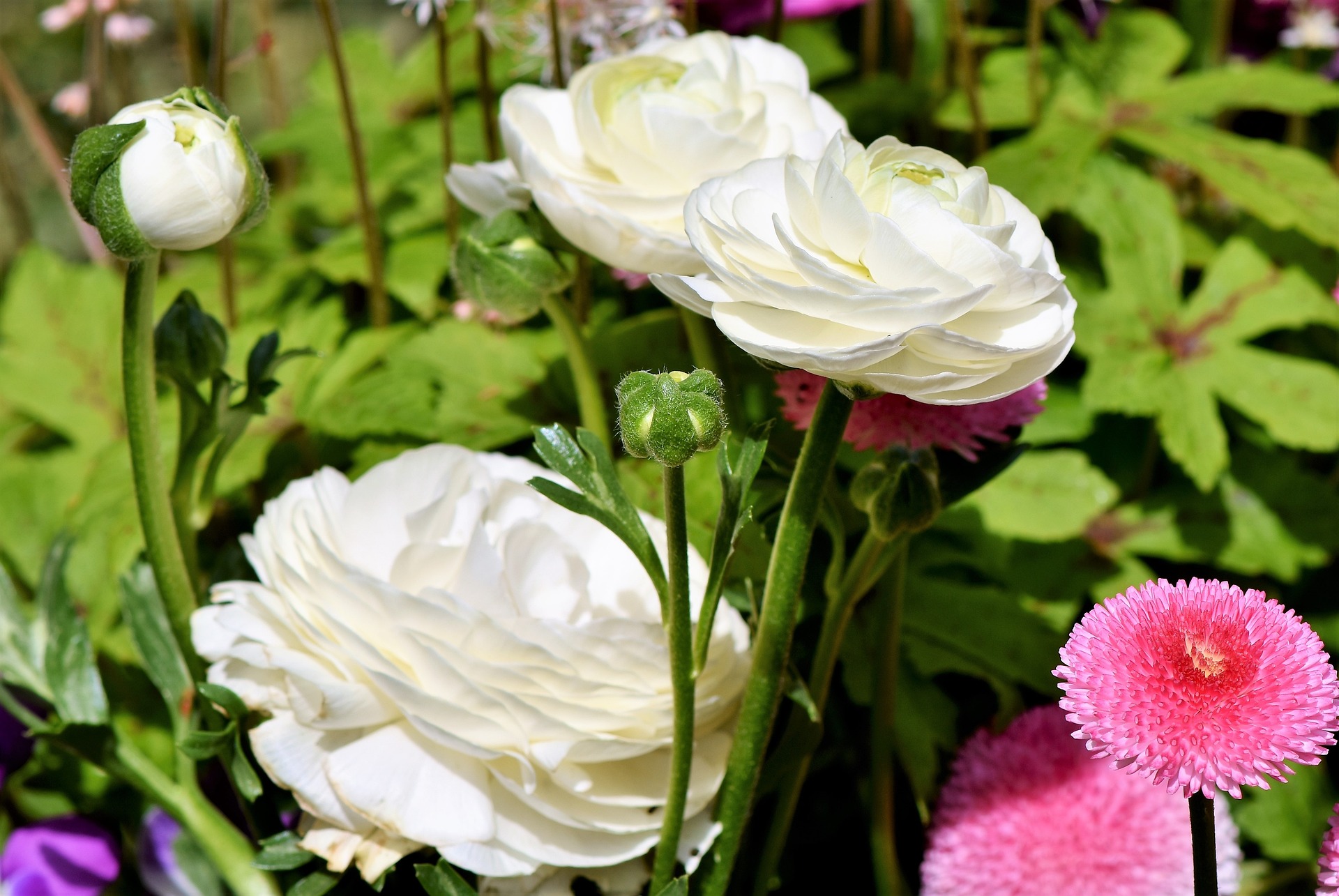
Ranunculus (buttercups) is very popular as houseplant with white flowers. It is also known as Persian buttercups. Their vibrant blooms and lush foliage add extra beauty to our garden. The flowers of Ranunculus are characterized by their layered, crepe-like petals. Ranunculus come in various colors, including yellow, white, pink, red, and orange. You can use Ranunculus for borders, flower beds, and containers. They add a burst of color to gardens.
Growing and Caring of Ranunculus
At first chose a location with full sun to partial shade. They thrive best with at least 6 hours of sunlight per day. Select well draining and fertile soil. Acidic to natural pH soil is best for them. Soil can be amended with compost to improve fertility and drainage. Regular water can keep the soil consistently moist but remember the soil must be not waterlogged. In cooler months, water is not necessary. Fertilizing is very important during the growing season. A balanced and slow release fertilizer can be applied. Prune the plants. It can encourage more blooms and prevent the plants from going to seed.
Pests and Problems
Though they are resistant to pests but you have to watch for aphids and snails. Monitor the plants properly and take care of them. Good air circulation can help to prevent disease too.
21. Hellebore
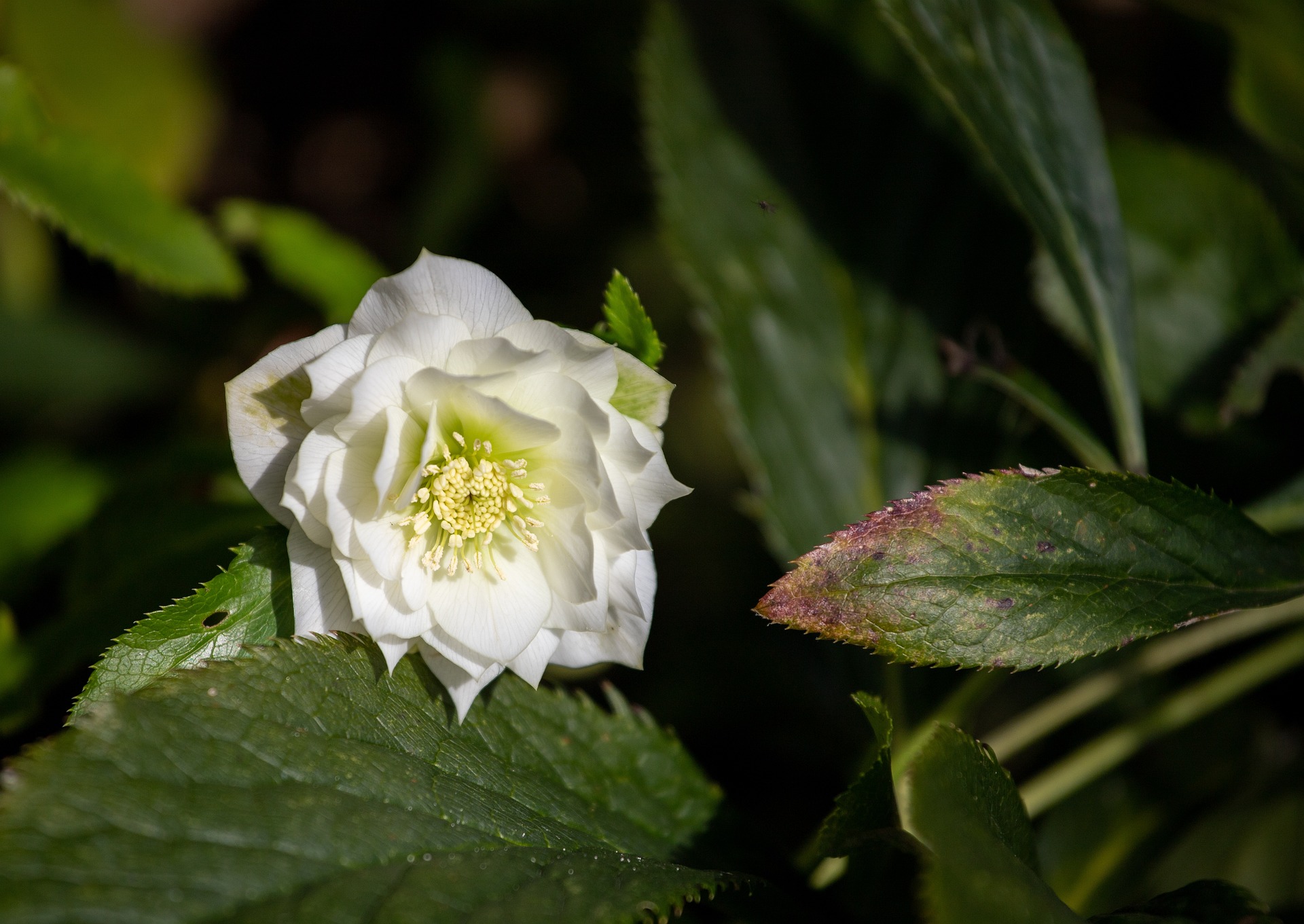
Hellebores( Lenten roses) is very famous as house plants with white flowers. It is a perennial plants with evergreen foliage. They often bloom from late winter to early spring. There are 2 varieties of hellebore, such as Helleborus Orientalis and Helleborus Niger.
Growing and Caring Conditions
Full sun is needed for Hellebores because it thrives best in dappled sunlight. They grow best in well-draining, rich, and slightly acidic soil. You can add organic matter which can great for soil developing. You have to water the soil regularly to Keep the soil consistently moist, especially during dry spells. Remember that the soil should not be waterlogged. In early spring, a balanced fertilizer can be used to support growth. If your soil is naturally rich,it would be best for hellebores. In late winter you have to start pruning to remove dead or damaged leaves.
Pests and Problems
Though hellebore resistant to pests but you have to ensure good air circulation to prevent aphids and slugs. Proper monitoring can help you in this process.
22. Tube Rose
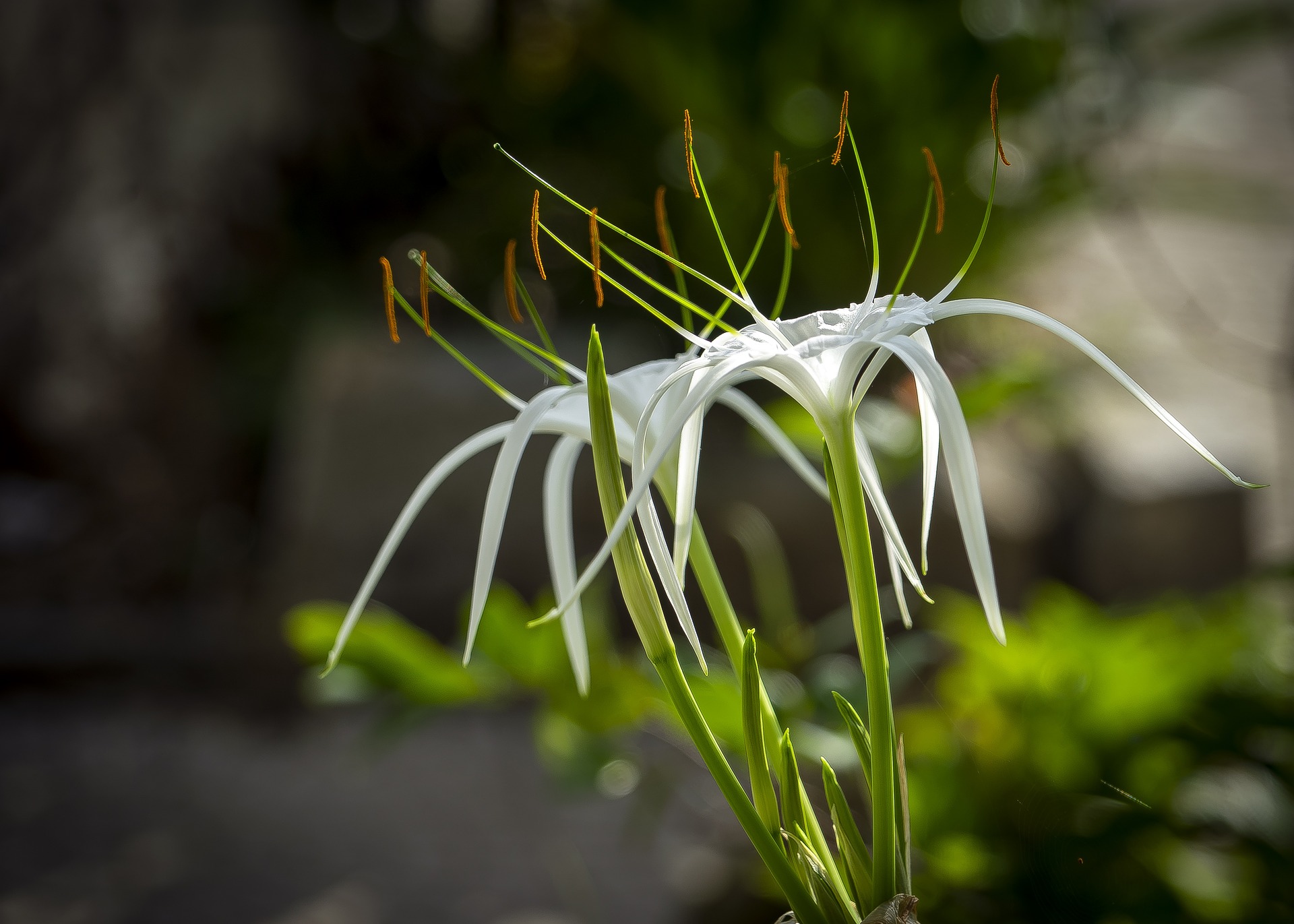
Tuberose is also called Polianthes Tuberosa. Its stunning blooms and sweet scent are very attractive. It produces tall spikes of tubular white flowers that bloom sequentially. The flowers create a lovely display.
Growing Conditions
Tube Rose thrive well in full sun (need at least 6-8 hours of sunlight each day).Choose well-draining soil which is rich in organic matter. Keep the soil consistently moist. You have to water the soil regularly especially during dry periods.
The soil should be allowed to dry slightly between waterings to prevent rot.You can use a balanced fertilizer every few weeks during the growing season. Fertilizer promotes healthy growth and flowering. Pruning can help you to remove spent flowers. Pruning encourage more blooms and maintain the plant’s appearance.
Pests and Diseases
Tube roses are generally resistant to pests, but you have to monitor the plants for aphids and spider mites. Good drainage and proper air circulation can help you to prevent bulb rot.
23. Crambe Maritima
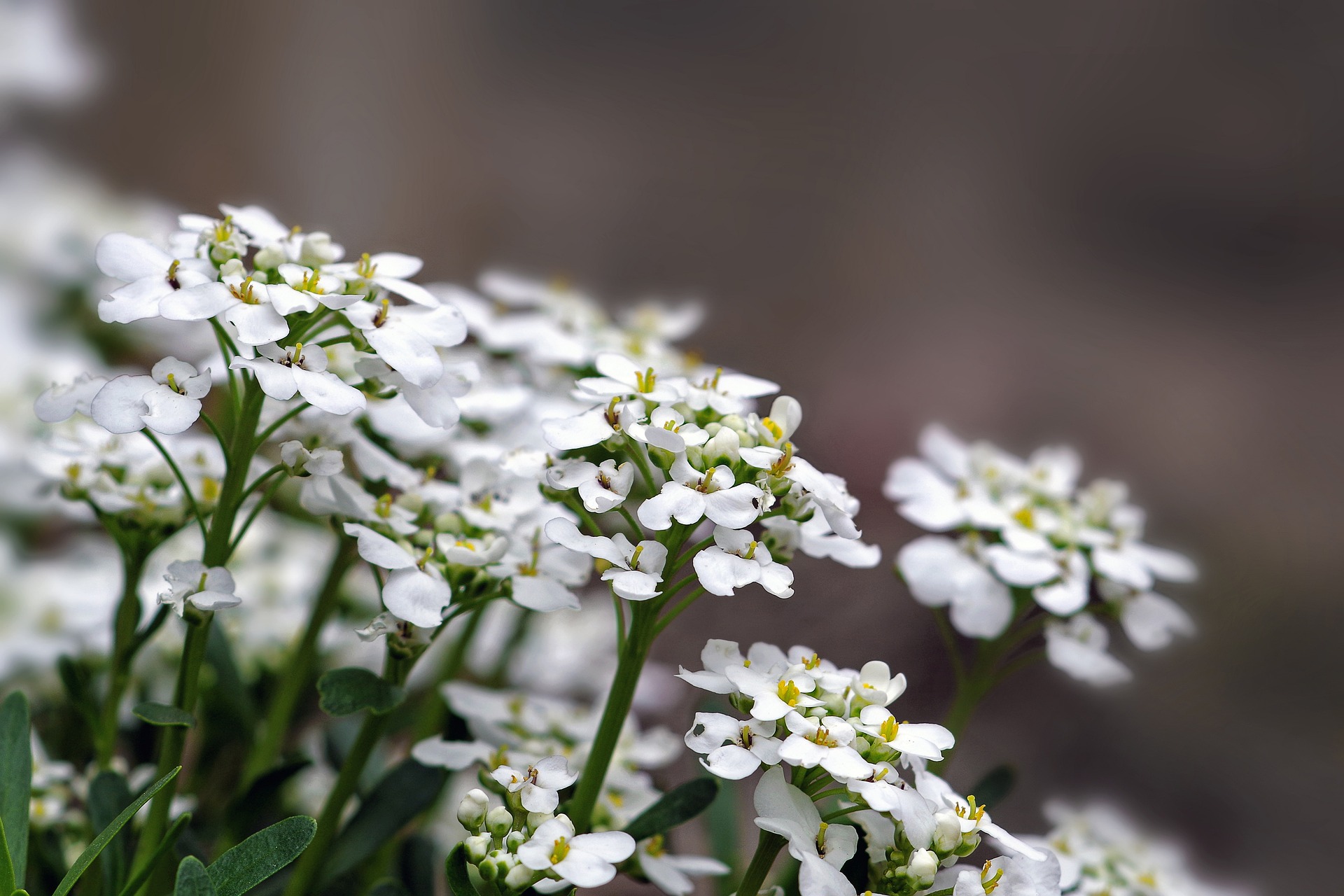
Crambe Maritima also called as sea kale. This plant is native to Europe and parts of Asia. It is famous for its large, fleshy leaves and clusters of small, white flowers. Usually it grows in sandy or rocky areas near the sea. Its leaves and shoots are edible and can be harvested in spring. It can add unique texture and a coastal feel in garden.
Growing and caring for Crambe Maritima
At first select a sunny spot and the soil should be sandy, loamy, well drained and rich in organic matter. Though it can thrives in coastal regions but can adapt to other areas. Too prevent root rot, you have to ensure good drainage. Space about 24 inches between plants to accommodate their spread. If you want to grow plant from seed, you have start seeds indoors 6-8 weeks before the last frost. Also you can sow them directly in the garden after the frost. To propagate from established plants, you can divide the roots in early spring or fall.
Water the soil regularly, especially during the dry spells. You can use a balanced fertilizer in the spring to encourage healthy growth. Add organic options like compost to improve the soil. Remove weeds regularly which can reduce competition for nutrients. You should remove spent flowers and dead leaves to promote airflow and prevent disease. Mulching also help you to retain moisture and suppress weeds. In colder climates, you can apply mulch in late fall to protect roots from freezing.
Harvesting
Edible parts can be eaten raw or cooked. You have to harvest young leaves and shoots in spring.
24. Moon Flower
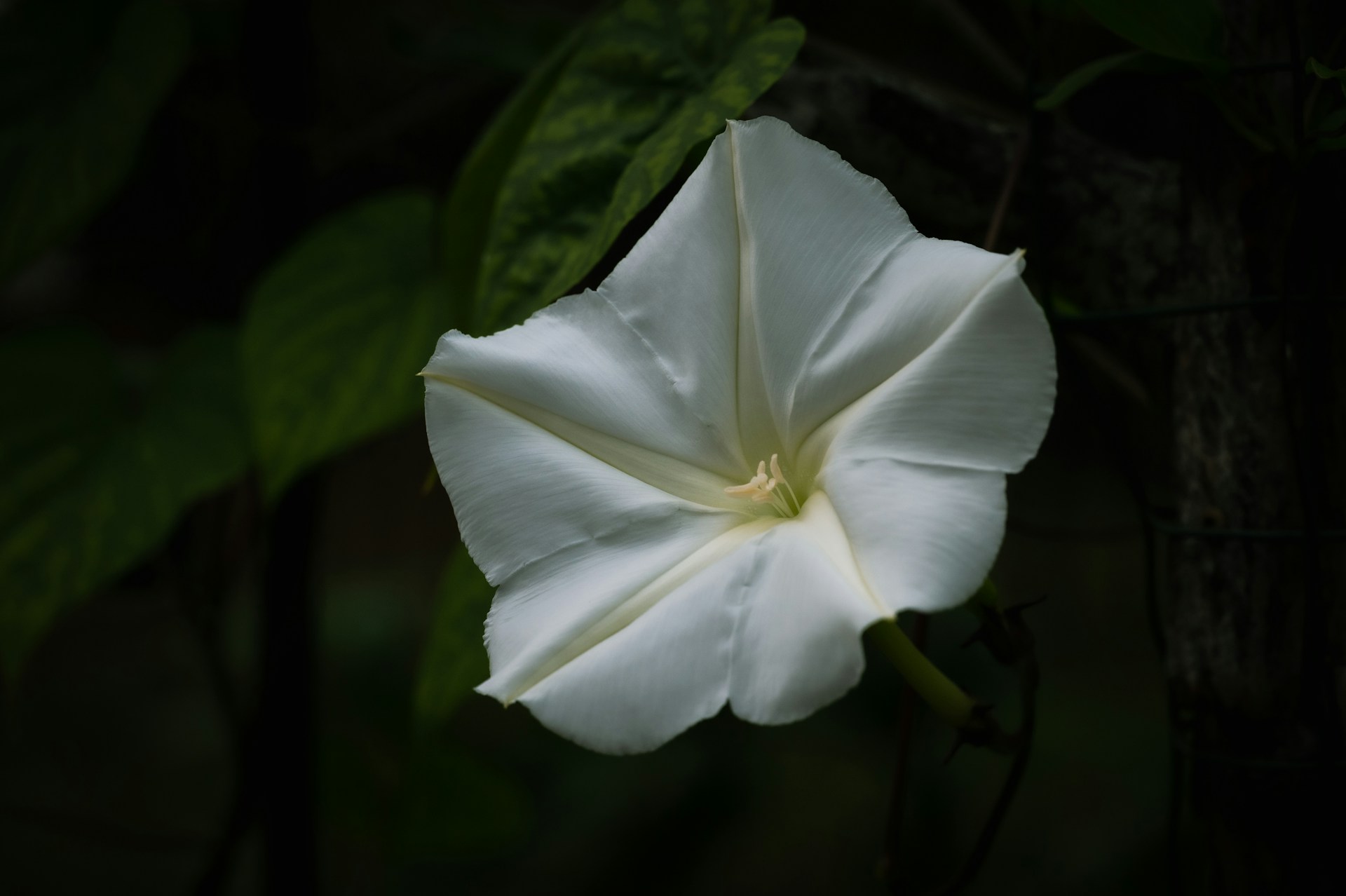
Moonflower is very popular as house plants with white flowers. It is also called Ipomoea alba. Night blooming plant belongs to the morning glory family. The large, white, trumpet-shape makes the flower unique. Moon flower open in the evening. It emit a sweet scent which attract pollinators like moths.
Growing and Caring Conditions
Select a location with full sun. The soil should be well-drained and fertile soil. You can use a slightly acidic to neutral pH to make the soil healthy. Seeds should be sown indoors 4-6 weeks before the last frost. Also you can sow seeds directly outdoors after the last frost. You can soak seeds overnight that can improve germination. Plant must be spaced about 12-24 inches apart.
Proper growth depends on regular watering too, so you have to Keep the soil consistently moist, especially during dry periods. Remember that waterlogged soil is not good for Moon flower. A balanced fertilizer also can promote healthy growth. This flowers plant need support for climbing as moonflowers can reach heights of up to 15 feet. Pruning can help young plants to encourage bushier growth and more blooms.
25. Anemone
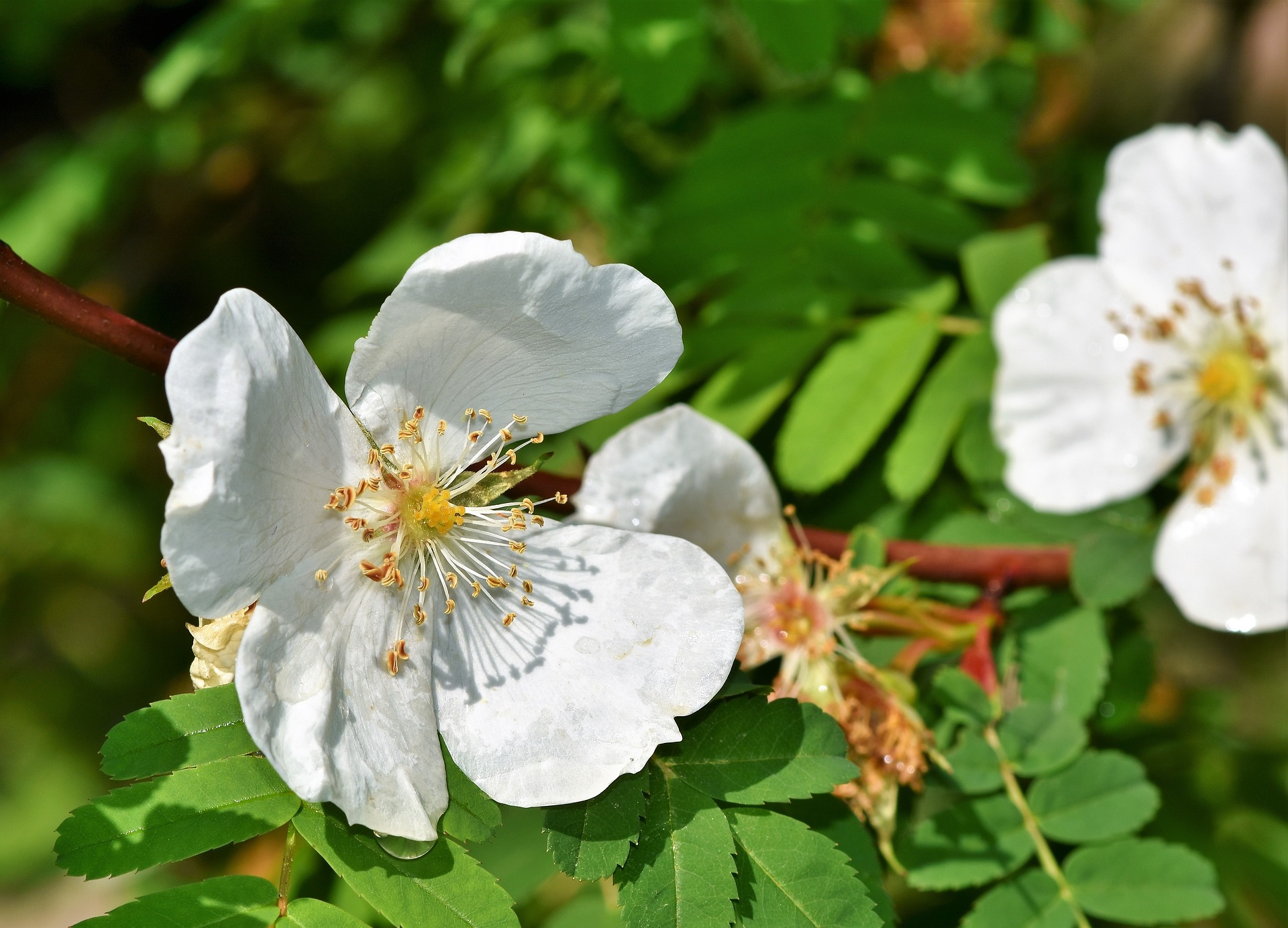
Anemones are known for their vibrant blooms. They belong to the family Ranunculaceae. There are different types of Anemone in the world such as, Wood Anemone (Anemone Nemorosa),Japanese Anemone (Anemone Hupehensis),Garden Anemone (Anemone Coronaria) etc.
Growing and Caring Conditions
Partial shade to full sun is best for Anemone. Well-drained, fertile soil is ideal is perfect for them. Some of them slightly acidic soil. Spring or fall is best time to plant tubers or seeds. Tubers should be planted about 2-4 inches deep, with the growth point facing up. During dry spells , the soil should be consistently moist. Applying mulch can help you to retain moisture and suppress weeds. Pruning can remove spent flowers to encourage further blooming and prevent seed formation. Use a balanced fertilizer which can be applied in spring. Fertilizer can promote growth and blooms.
Pests and Diseases
Always keep an eye on the garden for aphids, slugs, and fungal issues. You can use organic remedies or insecticidal soap.
Related Topic: Most Beautiful Pink Flowering Trees In Florida
Conclusion
White flowers stay in our heart and mind for their purity and beauty. If like me, white flowers are favourite to you, you should read all the ideas properly. By following the techniques and ideas, you can grow and enjoy a white flowers garden in your house easily.

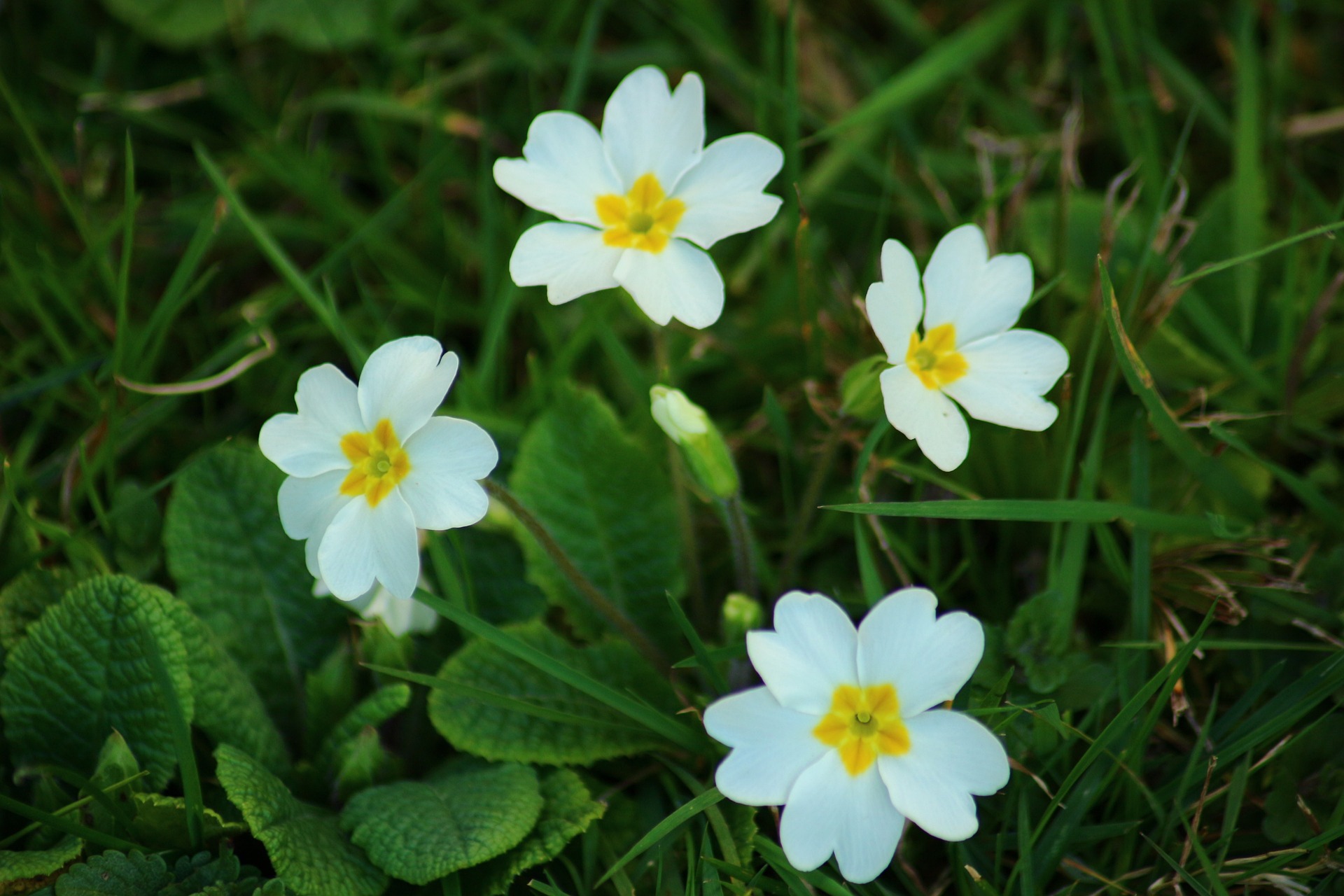
2 Responses